Let’s enter the joy of Christmas in Germany by discovering the Weihnachtsmarkt tradition.
The Christmas markets in Germany are indeed an age-old tradition.
During Advent, thousands of markets open their doors to visitors.
Their stallholders sell seasonal gifts and mouth-watering treats in the crisp winter air. But it’s not just about shopping.
People also come there for the atmosphere.
The picturesque streets and squares offer a beautiful backdrop to the Christmas markets with enchanting decorations and illumination.
In this article, we’ll look at the origins and traditions of the Weihnachtsmarkt before giving you a list of 30 of the best Christmas markets to visit in Germany!
BONUS – check out my top tips for visiting the Christmas Markets in Germany at the bottom of the article!
🎦 Watch our short video about Christmas in Germany to get inspired! ⤵
Why you should discover Germany at Christmas
I have fond childhood memories of Christmas in Germany.
It was in the 1980s, and we lived in Speyer in Rhineland-Palatinate.
At that time, only Strasbourg had a Christmas market in France, and few French people knew their existence in Germany.
For me, as a child, the lights and sweet smells of the German Christmas markets amazed me. From Mainz to Heidelberg, Christmas in Germany had a special meaning for me. The lights, the decorations, the bells ringing at midnight… oh and the gingerbread, roaster chestnuts and Vienna almonds!
From Landau with love!
When I went to school in the German town of Landau-in-der-Pfalz, I had no idea that it was the birthplace of Thomas Nast (who emigrated to the US with his family as a young boy).
Even if you don’t know his name, Nast (1840-1902) is responsible for something significant that has shaped the Christmas we know today.
Indeed, the German-American political cartoonist gave us the modern image of Santa Claus when his Christmas illustrations for Harper’s Weekly were published in the 1860s. Today, the Landau Christmas Market bears the name of Thomas-Nast-Nikolausmarkt.
From Germany to Alsace
I can tell you that when our family returned permanently to Alsace in France in 1990, I was a bit uprooted. Because if Alsace is nowadays recognised as a “Land of Christmas” and a reference in the field in France and even in Europe, it was not yet the case in the early 1990s. The popular rise of Christmas in Alsace came a little later, towards the end of the decade.
In fact, Christmas traditions in Alsace are very similar to those in Germany.
And for good reason: the now French province was a German land for several centuries. Until the 17th century, Alsace was part of the Holy Roman Empire.
And despite the tragedies of wars, the French province has never denied its Germanic origins, proud to be a bridge between the Latin and Germanic worlds.

So why is Advent in Germany worth a visit?
First of all, Germany is a land of tradition. From the end of November onwards, the Advent season prepares people for Christmas. The excitement of Christmas is indeed in full swing during the four weekends of Advent.
This is the time for Christmas markets, wreaths and advent calendars, Christmas trees in the centre of squares, illuminations in the shopping streets of towns and villages…
But also the making of Christmas delicacies: Christmas biscuits, lebkuchen and other gingerbread, not forgetting the Christmas stollen.
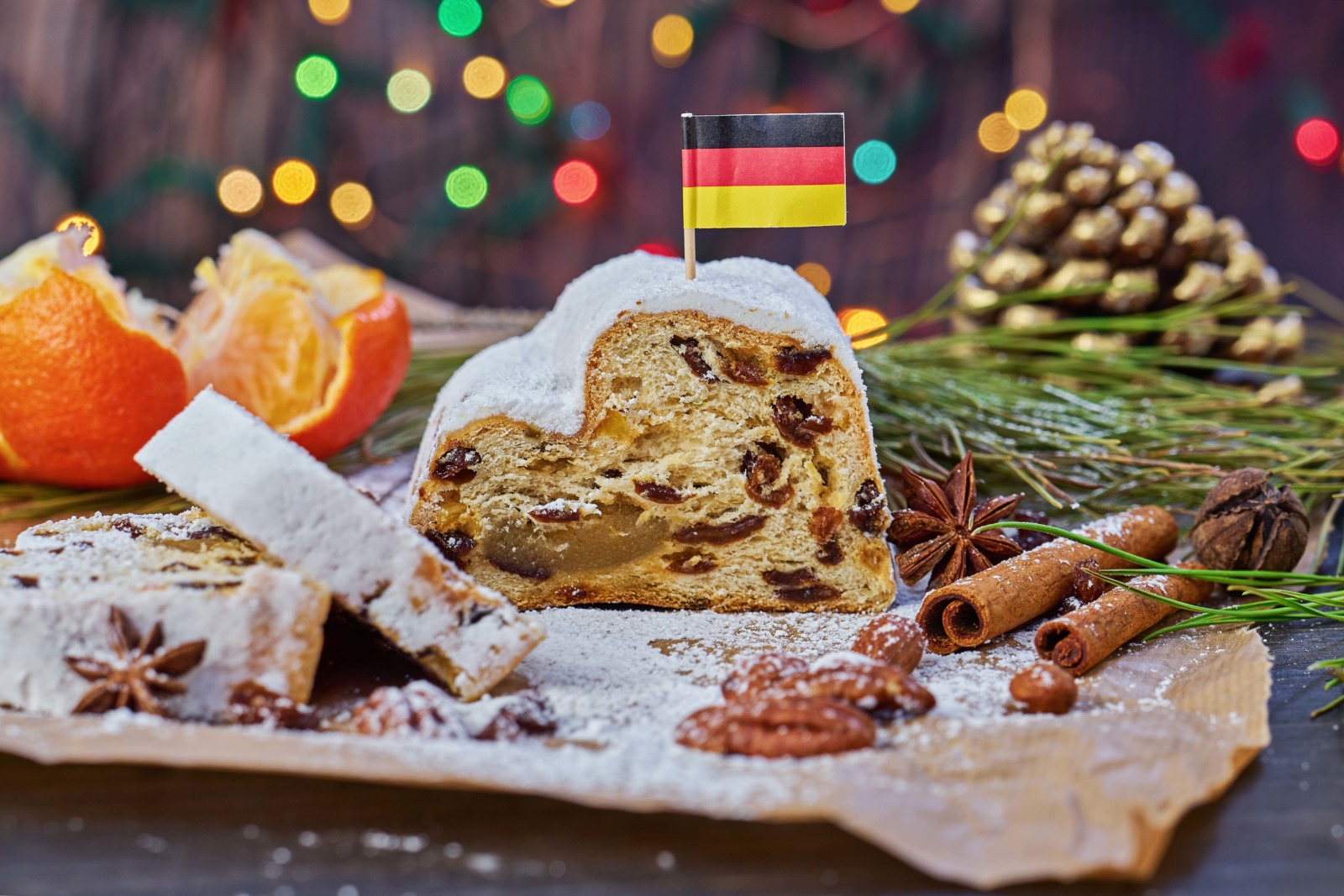
The history of German Christmas markets
Many winter traditions from our distant past, including the decorated Christmas tree, have roots in Northern Europe, especially in Germany.
The Christmas market is one of the Germanic Christmas traditions newly established in France, Great Britain and North America.
These markets have a long history in Germany and Austria, especially considering their medieval precursors: the St. Nicholas markets.
![Heidelberg Christmas Market © Daderot - licence [CC0] from Wikimedia Commons](https://frenchmoments.eu/wp-content/uploads/2021/11/Heidelberg-Christmas-Market-2-©-Daderot-licence-CC0-from-Wikimedia-Commons.jpg)
The medieval St. Nicholas markets
For example, as early as 1294, a municipal ordinance of the city of Vienna in Austria mentions the organisation of a St. Nicholas market. This is the oldest written record of such a market.
Similar markets are mentioned in municipal ordinances throughout the Holy Roman Empire.
For example, the Nicolausmarkt in Munich dates from 1310 and that in Frankfurt from 1393. Strasbourg, then a Free City of the Empire, held its market in front of the cathedral.
Then, in 1434, Elector Frederick II authorised the organisation of a market in Dresden on the Monday before Christmas. Known as the Striezelmarkt, it allowed the people of Dresden to stock up on food for the Christmas meal. It takes its name from the traditional Dresden cake: the Strietzel. It is considered to be the oldest Christmas market in the world.
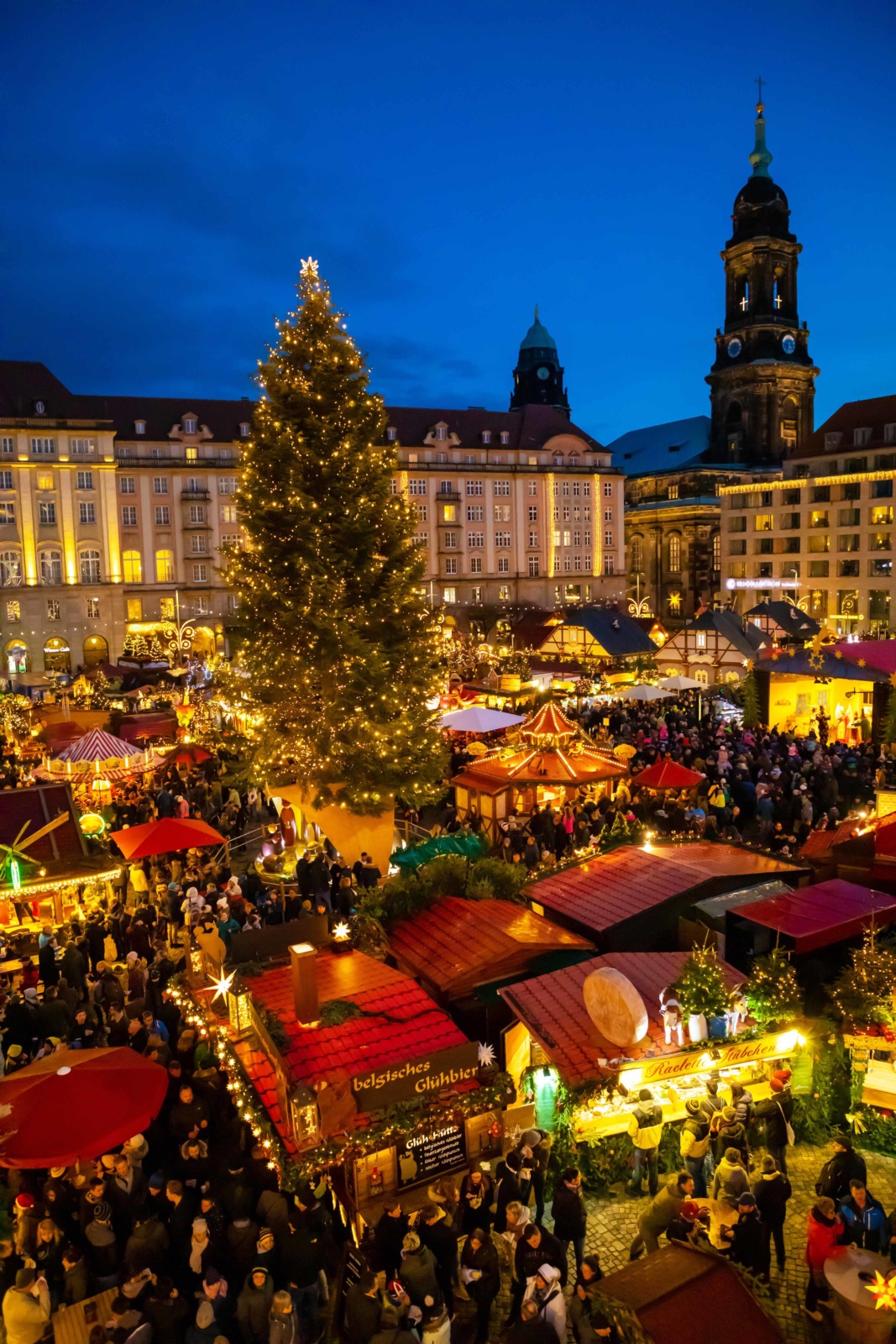
The shift to the Christkindlmarkt at the Reformation
Then came the Protestant Reformation. This break with Catholicism led to a change in local traditions in the Holy Roman Empire.
Protestantism did not favour the worship of saints. As a result, the St. Nicholas markets held in regions that had converted to Protestantism were simply cancelled.
In Strasbourg, the Protestant preacher Johannes Flinner convinced the city council to ban the St. Nicholas market. He considered it to be a “relic of papism”. Flinner demanded that from now on, children should receive their presents from the Christ Child, not from St. Nicholas.
This decision had made some people unhappy: the traders!
To satisfy them, it was agreed in 1570 to open a market that would take place one week before 25 December. Centred on the Nativity Festival, the market was renamed “Christkindelsmärik” in the Alsatian dialect or Christkindlmarkt. Other German cities followed in the years and centuries to come: Nuremberg in 1628, Vienna in 1764, Munich in 1806…
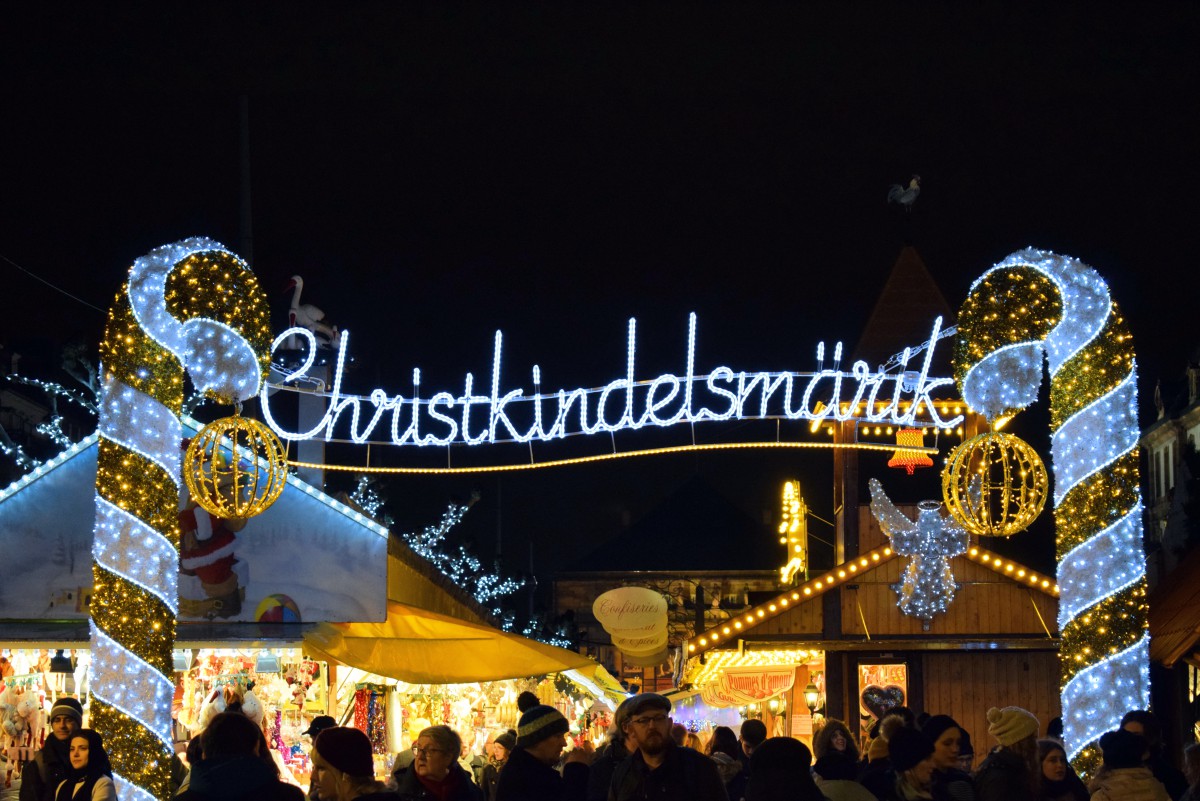
What is sold at a Christmas market?
Most German Christmas markets start around the first weekend of Advent and continue until Christmas Eve or just before.
Originally, the stalls at St. Nicholas markets sold meat, warming wool and various items for the cold winter season. In the 14th century, toymakers, basket makers and confectioners were also allowed to set up their own stalls.
In addition to the craft and decoration stalls that are particularly suited to Christmas and the gift-giving season, the larger Christmas markets may also feature choirs and children’s rides, decorative structures (Christmas pyramids, Christmas trees, monumental entrance arches), open-air skating rinks and a wide variety of dishes, without forgetting the inevitable Glühwein.

As for the typical chalets of some Christmas markets in southern Germany, they only appeared in the 19th century. However, many German Christmas markets have kept their traditional stalls (with sheets stretched over wooden posts).
What are Christmas markets in Germany called?
German Christmas markets have several names:
- Der Weihnachtsmarkt (Christmas market) – the generic term and its plural, die Weihnachtsmärkte. Mainz’s Christmas market is der Mainzer Weihnachtsmarkt,
- Der Christkindlmarkt (Christ Child Market), especially in southern German countries (including Alsace, German-speaking Switzerland and Austria),
- local names: Gendarmenmarkt (Berlin), Kugelmarkt (Lauscha), Sternschnuppenmarkt (Wiesbaden), Striezelmarkt (Dresden), Thomas-Nast-Nikolausmarkt (Landau), Wenzelsmarkt (Bautzen)…
Christmas things to do in Germany
While visiting the German Christmas markets, why not join one of the following activities?
Our partner Get Your Guide offers several activities that will appeal to children and adults: a children’s Christmas show in Berlin, a visit to the Dresden Christmas market with Stollen and Glühwein tasting, a raclette and wine evening in Stuttgart… Enter the enchanting world of Advent in Germany!
Top 30 Christmas markets in Germany
It is almost impossible to give several Christmas markets that are held in Germany every year. It is estimated that there are between 1,500 and 3,000 of them, some permanent, and others (especially in smaller towns) are only held on one day or weekend. With around 250 stalls, the Leipzig Christmas market is one of the largest in the country. Berlin alone has about 80 markets, including the popular Gendarmenmarkt and the Spandau market!
To introduce you to some of the best Christmas markets in Germany, I called on a handful of bloggers who kindly accepted the invitation.
Below is a selection of their favourite Christmas markets and the link to their blogs. I’ve also added some of my favourites to complete the overview. Let us know in the comments below which is your favourite or if another great German Christmas market is missing.
Please note that some Christmas markets charge a small entrance fee from 1 to 3 euros.
AACHEN CHRISTMAS MARKET
![Aachen Christmas Market © Amel - licence [CC BY-SA 3.0] from Wikimedia Commons](https://frenchmoments.eu/wp-content/uploads/2021/11/Aachen-Christmas-Market-©-Amel-licence-CC-BY-SA-3.0-from-Wikimedia-Commons.jpg)
During the four weeks of Advent, the squares and streets around the Aachen Cathedral and the town hall welcome a Christmas village: the Aachener Weihnachtsmarkt.
The Aachen Christmas market only dates back to the 1970s and originally took the name of Printenmarkt. The festive event draws more than 1.5 million visitors from Germany and the neighbouring countries of Belgium and the Netherlands.
Stroll in the illuminated streets of the old town centre, creating a superb backdrop to the Christmas market.
The 120 stalls offer all sorts of gift ideas, decorations, and local culinary specialities such as gingerbread, speculoos, marzipan and the famous Aachener Printen.
![Aachener Printen © SKopp - licence [CC BY-SA 3.0] from Wikimedia Commons](https://frenchmoments.eu/wp-content/uploads/2021/11/Aachener-Printen-©-SKopp-licence-CC-BY-SA-3.0-from-Wikimedia-Commons.jpg)
The Printen is a type of Lebkuchen sweetened with a syrup made from sugar beets and includes cinnamon, aniseed, clove, cardamom, coriander and ginger… although the exact recipe is a closely kept secret from Aachen bakeries.
Plan your visit to the Aachen Christmas Market
- ℹ️ The official website of the Aachen Christmas Market with practical info (opening dates and times, location and more)
- 🛌 Where to stay in Aachen: choose from a wide selection of accommodation
AUGSBURG CHRISTMAS MARKET
![Augsburg Christmas Market © Maximus photographie - licence [CC BY-SA 3.0] from Wikimedia Commons](https://frenchmoments.eu/wp-content/uploads/2021/11/Augsburg-Christmas-Market-©-Maximus-photographie-licence-CC-BY-SA-3.0-from-Wikimedia-Commons-1.jpg)
The Augsburg Christkindlesmarkt dates back to 1498 and is one of the oldest Christmas markets in Germany. In the late Middle Ages, it took the name of Lebzeltermarkt. The old town hall welcomed a gingerbread market from 1527.
Since 1963, the Christmas market has occupied the Rathausplatz, the Augsburg town hall square. Other smaller Christmas markets occur in other parts of the city: Fuggerplatz, Martin-Luther-Platz, Moritzplatz and Königsplatz/Bahnhofstrasse.
Since 1977, the Augsburg Christkindlesmarkt has been famous for its Engelesspiel (Angels Play). On the Advent weekends at 6 pm, 14 angels appear in the windows and balcony of the town hall in a musical display. The play is based on the model of Hans Holbein’s famous altar angels in the facade of the Augsburg town hall. (In 2020 and 2021, the Engelesspiel was cancelled due to the pandemic.)
Augsburg at Christmas is a popular place to be. Around one million visitors from Germany and abroad enjoy its festive ambience yearly.
Plan your visit to the Augsburg Christmas Market
- ℹ️ The official website of the Augsburg Christkindlesmarkt with practical info (opening dates and times, location and more)
- 🛌 Where to stay in Augsburg: choose from a wide selection of accommodation
BADEN BADEN CHRISTMAS MARKET
The Baden Baden Christmas Market takes place in one of the most beautiful areas of the Black Forest. The mountains surrounding the international spa town form a wonderful backdrop to the Christkindlesmarkt.
You will find the festive event between the 160-year-old colonnades of the Kurhaus. Around 100 decorated stalls offer a range of handicrafts, Christmas decorations, nativity scenes, exclusive women’s and men’s fashion, accessories, antiques, and other gift ideas.
There is a yesteryear merry-go-round in front of the Fieser Bridge.
Plan your visit to the Baden Baden Christmas Market
- ℹ️ The official website of the Heidelberg Christmas Market with practical info (opening dates and times, location and more)
- 🛌 Where to stay in Baden Baden: choose from a wide selection of accommodation
- 🏰 What to do in Baden Baden: check out the top activities in the city 👇
BAUTZEN CHRISTMAS MARKET
![Bautzen Weihnachtsmarkt © Julian Nyča - licence [CC BY-SA 3.0] from Wikimedia Commons](https://frenchmoments.eu/wp-content/uploads/2021/11/Bautzen-Weihnachtsmarkt-©-Julian-Nyča-licence-CC-BY-SA-3.0-from-Wikimedia-Commons.jpg)
In 2021, the historic town of Bautzen will host the 638th edition of the famous Bautzen Wenzelsmarkt. The romantic setting of the old town of Bautzen is the setting for the oldest Christmas market in Germany.
In 1384, the Bohemian king Wenceslas IV granted the town of Bautzen the right to hold a free meat market. Every butcher had the right to sell his meat publicly on the market on Saturdays from Michaelmas (11 November) until Christmas.
In 1402, Wenceslas IV placed the city’s markets under royal protection. King Wladislaus confirmed this right with a certificate in 1505. Thus, the Christmas market still bears the name of King Wenceslas IV: the Bautzen Wenzelsmarkt.
Traditionally, the Wenzelsmarkt opens during the four weeks of Advent. The Christmas route leads through the romantic old town of Bautzen, from Hauptmarkt to Reichenstraße, surrounded by magnificent baroque houses.
The decorated stalls and the illuminated Christmas tree create a unique Christmas atmosphere.
On the second weekend of Advent, the Möchskirchruine hosts a historic Christmas market with medieval music, food and drink vendors, jugglers and fire-eaters, and medieval sword fights.
Plan your visit to the Bautzen Christmas Market
- ℹ️ The official website of the Bautzen Christmas Market with practical info (opening dates and times, location and more)
- 🛌 Where to stay in Bautzen: choose from a wide selection of accommodation
- 🏰 What to do in Bautzen: check out the top activities in the city 👇
BERLIN, GENDARMENMARKT
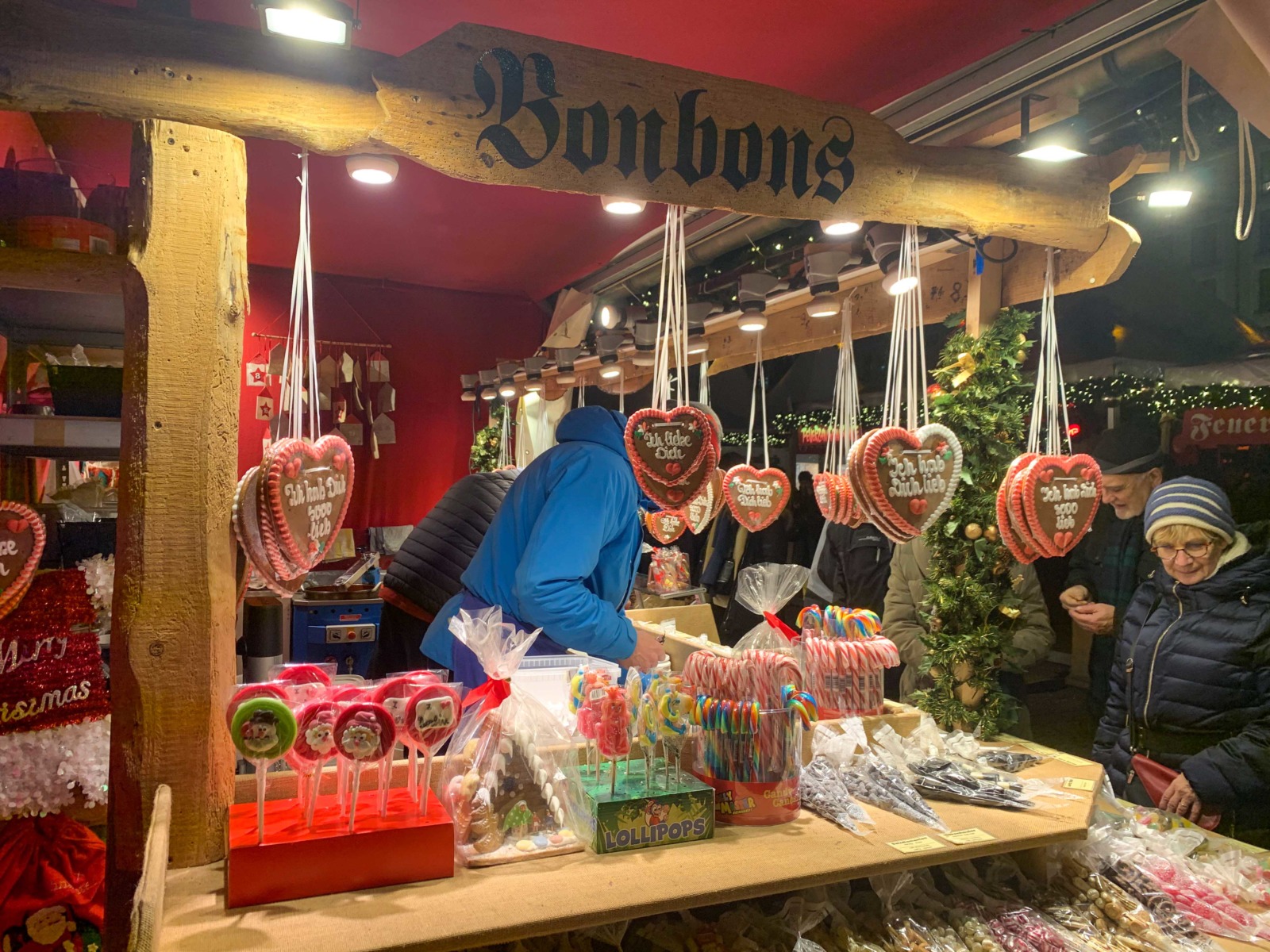
By Sydney of A World in Reach • Follow on Pinterest
With more than 80 unique Christmas markets throughout the city, you’re spoiled for choice when visiting Berlin. One of the best Christmas Markets in the city is the WeihnachtsZauber Christmas Market at Gendarmenmarkt, located in the beautiful Gendarmenmarkt Square.
The WeihnachtsZauber Christmas Market, often known as just the Gendarmenmarkt Christmas Market, is one of the most popular markets in Berlin. The market is a traditional German Christmas Market made up of wooden stalls selling handmade gifts, tasty snacks, and delicious seasonal drinks. Don’t visit the market without sampling roasted nuts, gingerbread cookies, currywurst, and a hot mug of delicious glühwein! In addition to the stalls, the market also has a beautiful Christmas tree and a stage with festive entertainment.
An ideal setting in central Berlin
The market is located in Berlin’s scenic Gendarmenmarkt Square, surrounded by gorgeous churches and the Berlin Concert Hall. The market is within walking distance of some of Berlin’s top attractions, such as Checkpoint Charlie, Brandenburg Gate, and Museum Island. You can also easily reach the market via the U-Bahn: the Hausvogteiplatz Station is just steps away.
The WeihnachtsZauber Christmas Market at Gendarmenmarkt is open yearly from late November through December 31 – if you’re visiting during these dates, make sure to add the market to your Berlin itinerary. The market ends with a bang with a celebration on New Year’s Eve – you can ring in the New Year with a live band, DJ, and fireworks while enjoying the beauty of the Christmas Market.
Admission to the WeihnachtsZauber Christmas Market at Gendarmenmarkt is €1, except on Monday-Friday from 11 am to 2 pm when it’s free to enter.
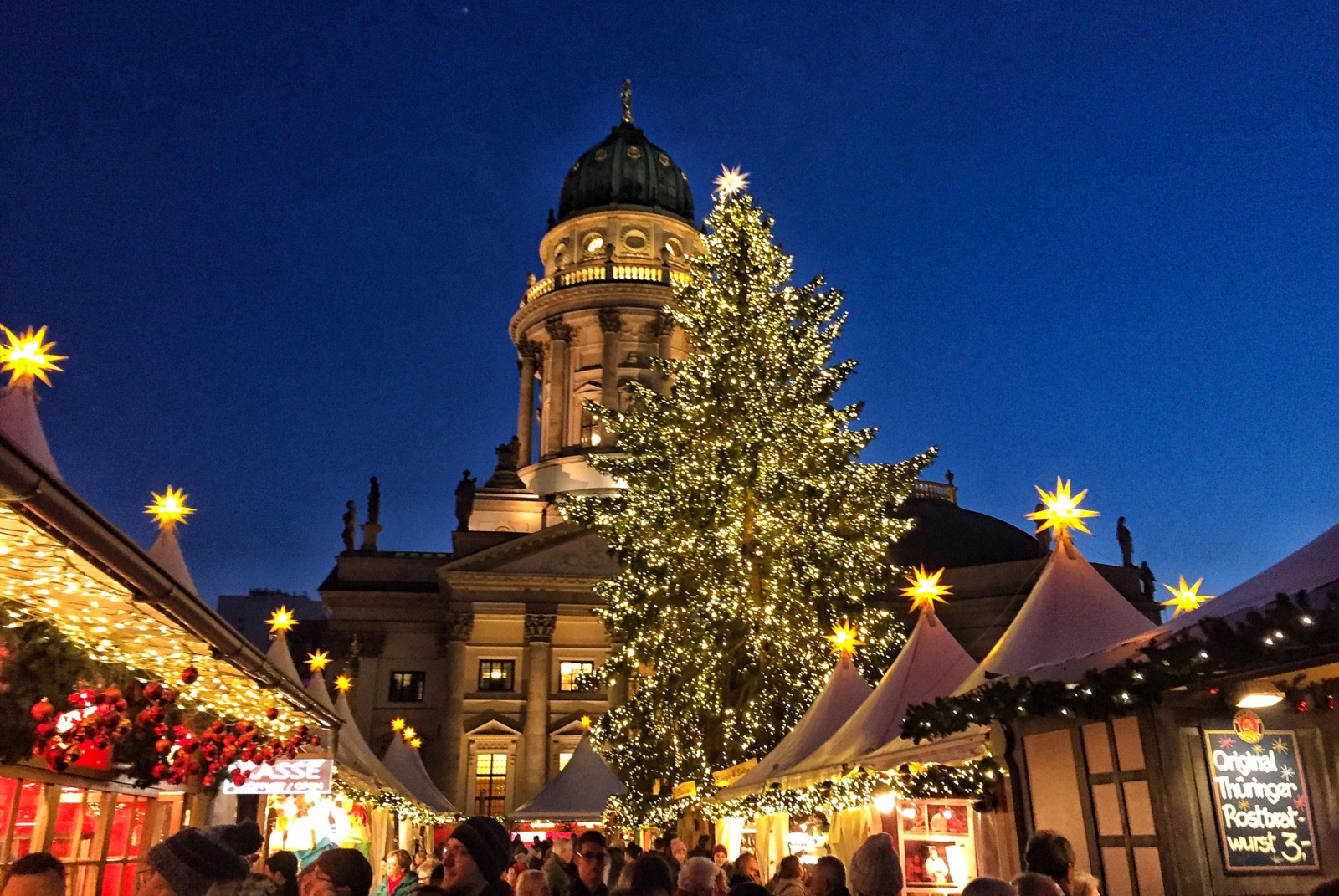
Plan your visit to the Berlin Christmas Markets
- ℹ️ The official website of Berlin at Christmas with practical info (opening dates and times, location and more)
- 🛌 Where to stay in Berlin: choose from a wide selection of accommodation
- 🏰 What to do in Berlin: check out the top activities in the city 👇
BRAUNSCHWEIG CHRISTMAS MARKET
![Braunschweig Christmas Market © Igge - licence [CC BY-SA 3.0] from Wikimedia Commons](https://frenchmoments.eu/wp-content/uploads/2021/11/Braunschweig-Christmas-Market-©-Igge-licence-CC-BY-SA-3.0-from-Wikimedia-Commons.jpg)
The Braunschweiger Weihnachtsmarkt has a tradition of over 300 years, and its origins date back to around 1500.
Its 140 stalls occupy the historic centre of Braunschweig, with Burgplatz as its centre. Historic buildings border the square: the St. Blasii cathedral, the Burg Dankwarderode, the Huneborstelschen Haus and the famous Braunschweiger Löwen. This unique architectural ensemble frames the Christmas market, giving it the privileged title of one of the most beautiful Christmas markets in Germany.
Thus, in the selection process, the organisers pay special attention to the attractiveness of the stalls and shops, which “must be in keeping with the traditional and historical overall vision of the Christmas market”. In Braunschweig, tradition is the order of the day!
Plan your visit to the Braunschweig Christmas Market
- ℹ️ The official website of the Braunschweig Christmas Market with practical info (opening dates and times, location and more)
- 🛌 Where to stay in Braunschweig: choose from a wide selection of accommodation
BREMEN CHRISTMAS MARKET
![Bremen Christmas Market © Corradox - licence [CC BY-SA 3.0] from Wikimedia Commons](https://frenchmoments.eu/wp-content/uploads/2021/11/Bremen-Christmas-Market-©-Corradox-licence-CC-BY-SA-3.0-from-Wikimedia-Commons.jpg)
Many visitors consider the Bremer Weihnachtsmarkt the most beautiful Christmas market in northern Germany. In 2019, the Bremen Christmas Market welcomed a record number of visitors (3.2 million), confirming the Hanseatic city’s attractiveness at Christmas.
The Christmas market has occupied the market square (Marktplatz) since 1857. Since then, the Christmas market has grown to around 200 stalls and is spread over several locations in the historic centre: around the Town Hall (Rathaus) and on the Domshof square, north of the cathedral.
The market stall sellers offer various products, including Christmas market food (pretzels, stollen, mulled wine), Christmas tree decorations, wooden toys and handicrafts.
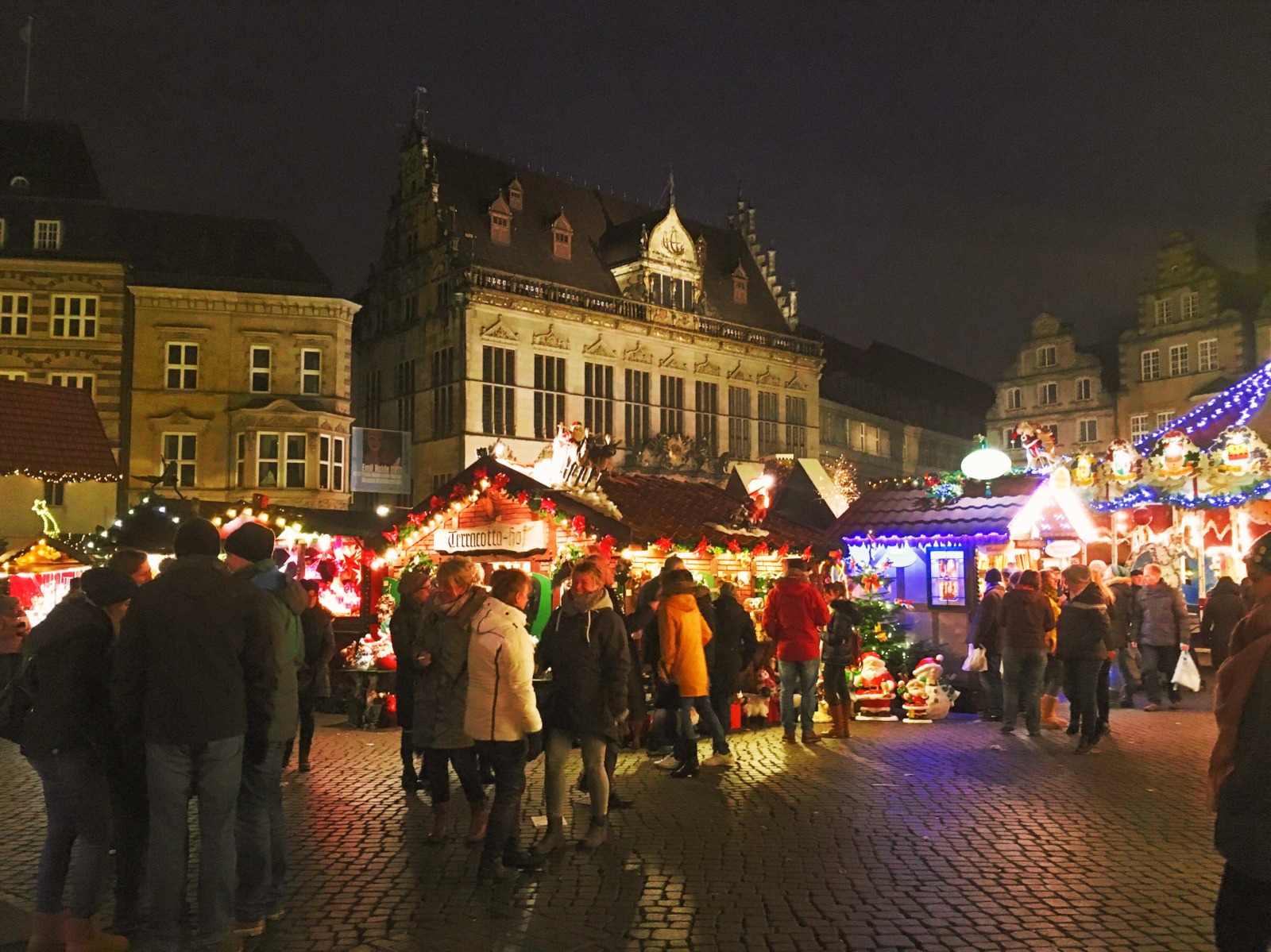
A large Christmas tree stands on the market square in front of the Bremen Citizenship Building (the City-State Parliament).
The banks of the River Weser on the Schlachte have a charming “medieval-maritime” feel during Advent. This is due to the small maritime Christmas market of the “Schlachte Winterzauber“. This takes place on the Schlachte promenade, which is illuminated in blue for the occasion.
Plan your visit to the Bremen Christmas Market
- ℹ️ The official website of the Bremen Christmas Market with practical info (opening dates and times, location and more)
- 🛌 Where to stay in Bremen: choose from a wide selection of accommodation
- 🏰 What to do in Bremen: check out the top activities in the city 👇
COLOGNE CHRISTMAS MARKET
![Cologne Christmas Market 2 © Eremeev - licence [CC BY-SA 3.0] from Wikimedia Commons](https://frenchmoments.eu/wp-content/uploads/2021/11/Cologne-Christmas-Market-2-©-Eremeev-licence-CC-BY-SA-3.0-from-Wikimedia-Commons.jpg)
The Cologne Christmas market is the most visited of all German Christmas markets, with more than five million visitors from Germany and all over Europe. In particular, foreign tourists from Great Britain and the Benelux countries travel here by bus.
The Christmas Market of Cologne Cathedral
Cologne has several Christmas markets in various parts of the city. The most famous is the Weihnachtsmarkt am Kölner Dom, the cathedral Christmas market. It stretches from the Domplatte to the Roncalliplatz and offers a majestic view of the cathedral’s south side.
![Christmas markets in Germany - Cologne Christmas Market © Superbass - licence [CC BY-SA 3.0] from Wikimedia Commons](https://frenchmoments.eu/wp-content/uploads/2021/11/Cologne-Christmas-Market-©-Superbass-licence-CC-BY-SA-3.0-from-Wikimedia-Commons.jpg)
Around a large illuminated Christmas tree, the Christmas market features 130 decorated stalls selling mainly handicrafts and gifts. These are fair-trade stands, and most of the food and drink sold is certified organic. The Christmas market also offers an extensive stage programme with over 100 free events.
Other Christmas markets in Cologne
The first Christmas market in Cologne dates from 5 December 1820. It took the name of Nicolai Market and occupied the Alter Markt. Today, the Christmas market on the Alter Markt has a theme based on Heinzelmännchen (elves). Unsurprisingly, you’ll see elves figurines decorating the 100 wooden stalls.
Other Christmas markets take place at Neumarkt (the Angel Christmas Market), Rudolfplatz, the Advent Market at Chlodwigplatz, the Christmas Market at the harbour…
![Christmas Markets in Germany - Cologne © Eremeev - licence [CC BY-SA 3.0] from Wikimedia Commons](https://frenchmoments.eu/wp-content/uploads/2021/11/Cologne-Christmas-Market-©-Eremeev-licence-CC-BY-SA-3.0-from-Wikimedia-Commons.jpg)
Plan your visit to the Cologne Christmas Market
- 🤩 The Cologne Christmas Market Discovery Guide
- ℹ️ Find out more about the Cologne Christmas Market with practical info (opening dates and times, location and more)
- 🛌 Where to stay in Cologne: choose from a wide selection of accommodation
- 🏰 What to do in Cologne: check out the top activities in the city 👇
DORTMUND CHRISTMAS MARKET
![Dortmund Weihnachtsmarkt © Riessdo - licence [CC BY 2.0] from Wikimedia Commons](https://frenchmoments.eu/wp-content/uploads/2021/11/Dortmund-Weihnachtsmarkt-©-Riessdo-licence-CC-BY-2.0-from-Wikimedia-Commons.jpg)
The Dortmunder Weihnachtsmarkt (or Dortmunder Weihnachtsstadt) is in its 122nd year in 2021. With its 300 stalls, it is one of the largest Christmas markets in Germany. It attracts more than 3.6 million visitors from Germany, the Benelux countries and Great Britain every year.
The focal point of the market is Hansaplatz, where is a large Christmas tree. Indeed, Dortmund boasts the largest Christmas tree in the world. Since 1997, a giant Christmas tree has been raised on Hansaplatz. It consists of about 1,700 individual trees attached to a steel frame. Together, they form a 45 m high conical tree, illuminated by 48,000 lamps and 20 electric candles 2.5 m high.
![Christmas markets in Germany - Dortmund © Andreas Vogel - licence [CC BY-SA 4.0] from Wikimedia Commons](https://frenchmoments.eu/wp-content/uploads/2021/11/Dortmund-Christmas-Market-Hansaplatz-©-Andreas-Vogel-licence-CC-BY-SA-4.0-from-Wikimedia-Commons.jpg)
The Christmas market stalls occupy the Hansaplatz at the foot of the tree, as well as the adjacent streets and squares: the Ater Markt, the Reinoldkirche area and the Wily-Brandt-Platz.
Since 1990, the various mulled wine stands have been serving their Glühwein in cups specially designed for the Dortmund Christmas Market. The mulled wine cups come from the Mohaba company in Düren and have since become collector’s items.
Plan your visit to the Dortmund Christmas Market
- ℹ️ The official website of the Dortmund Christmas Market with practical info (opening dates and times, location and more)
- 🛌 Where to stay in Dortmund: choose from a wide selection of accommodation
- 🏰 What to do in Dortmund: check out the top activities in the city 👇
DRESDEN CHRISTMAS MARKET
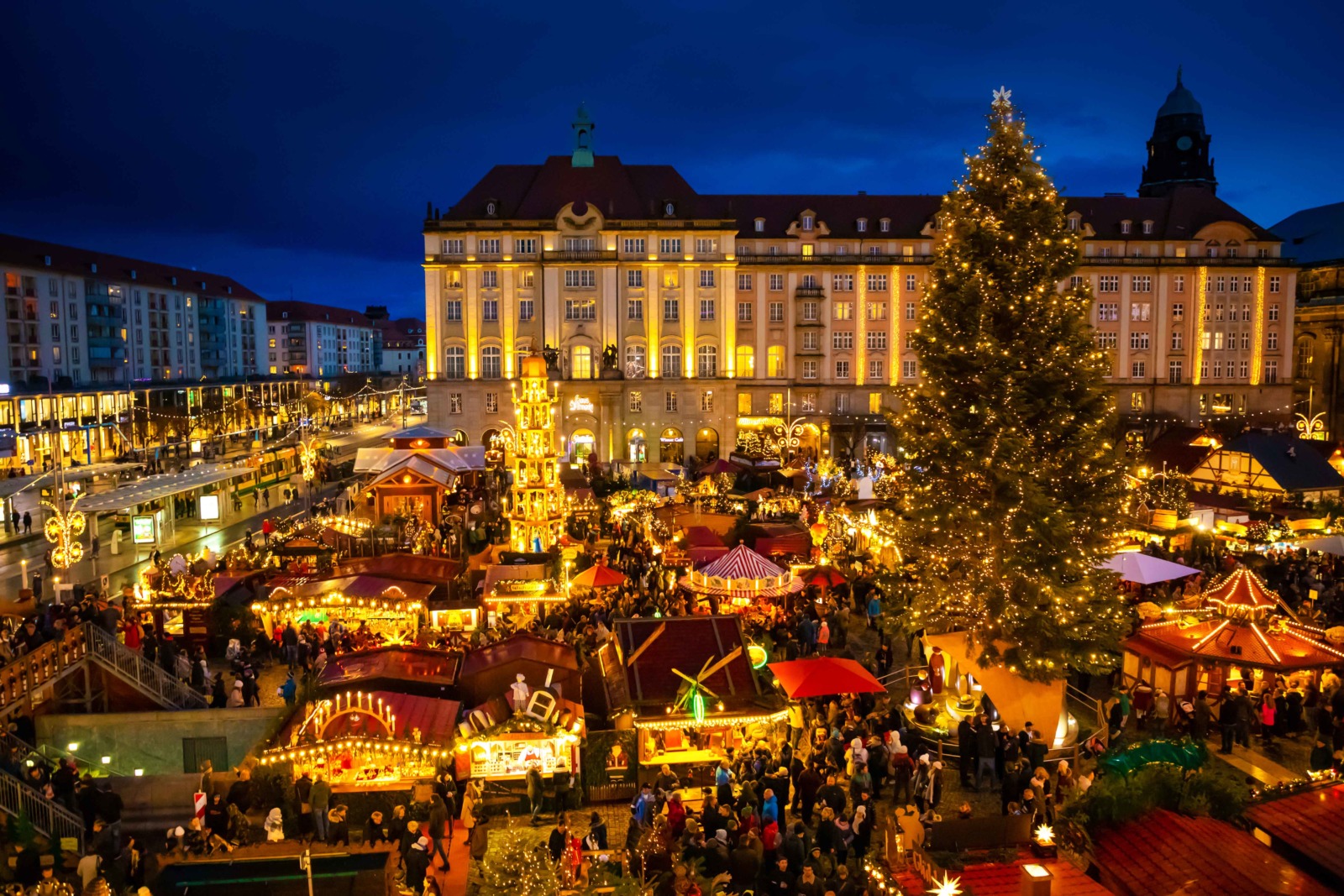
By Maria of EuropeUpClose • Follow on Facebook
Dresden is a popular Christmas Market destination in Germany. The city has several Christmas Markets to choose from, each with its own ambience and flair.
The Striezelmarkt
The most famous one is the Striezelmarkt, which dates back to 1434 and makes it the oldest Christmas Market in Germany. One of the main events is the annual world record attempt for the longest Christstollen, a traditional German Christmas fruit cake. The current record lies at over 4 tons! Make sure to try a piece of this iconic cake and wash it down with a hot Glühwein!
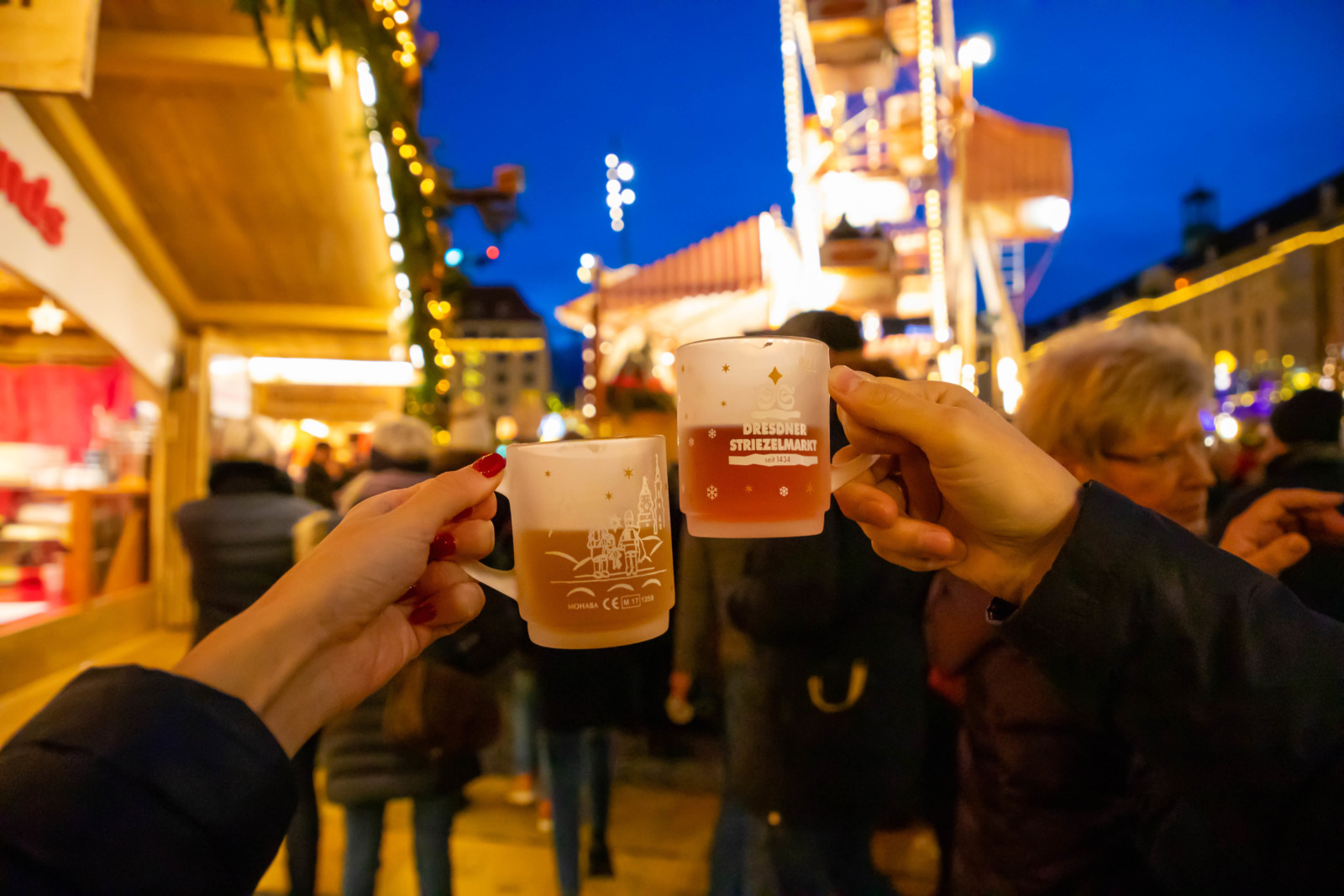
The second-largest Christmas Market in Dresden is called Augustusmarkt and is famous for its international flair. You can find traditional Christmas food, decor, and gifts from all over the world. It almost feels like a Christmas-themed trip around the world.
The Winter Lights Market
Another market you should not miss is the Winter Lights Market. It is located on Dresden’s most famous shopping street and has the most elaborate and sparkly Christmas lights, including a 50-foot tall Christmas tree. This market is a great choice if you are travelling with kids or want to do some Christmas shopping at the same time.
If you love Christmas markets, definitely put Dresden on your list of places to go!
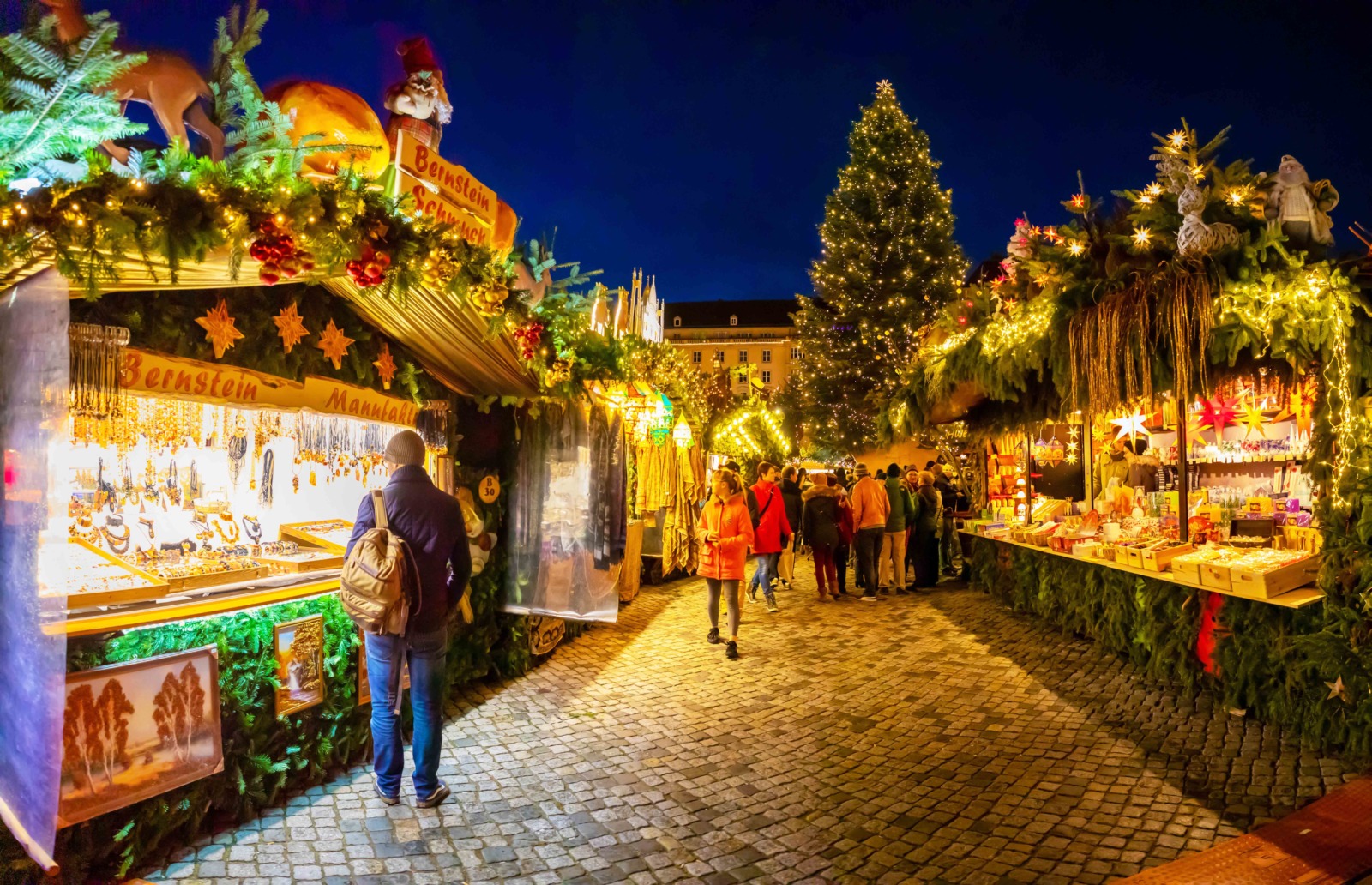
Plan your visit to the Dresden Christmas Market
- 🤩 The Dresden Christmas Market Discovery Guide
- ℹ️ The official website of the Dresden Christmas Market with practical info (opening dates and times, location and more)
- 🛌 Where to stay in Dresden: choose from a wide selection of accommodation
- 🏰 What to do in Dresden: check out the top activities in the city 👇
ERFURT CHRISTMAS MARKET
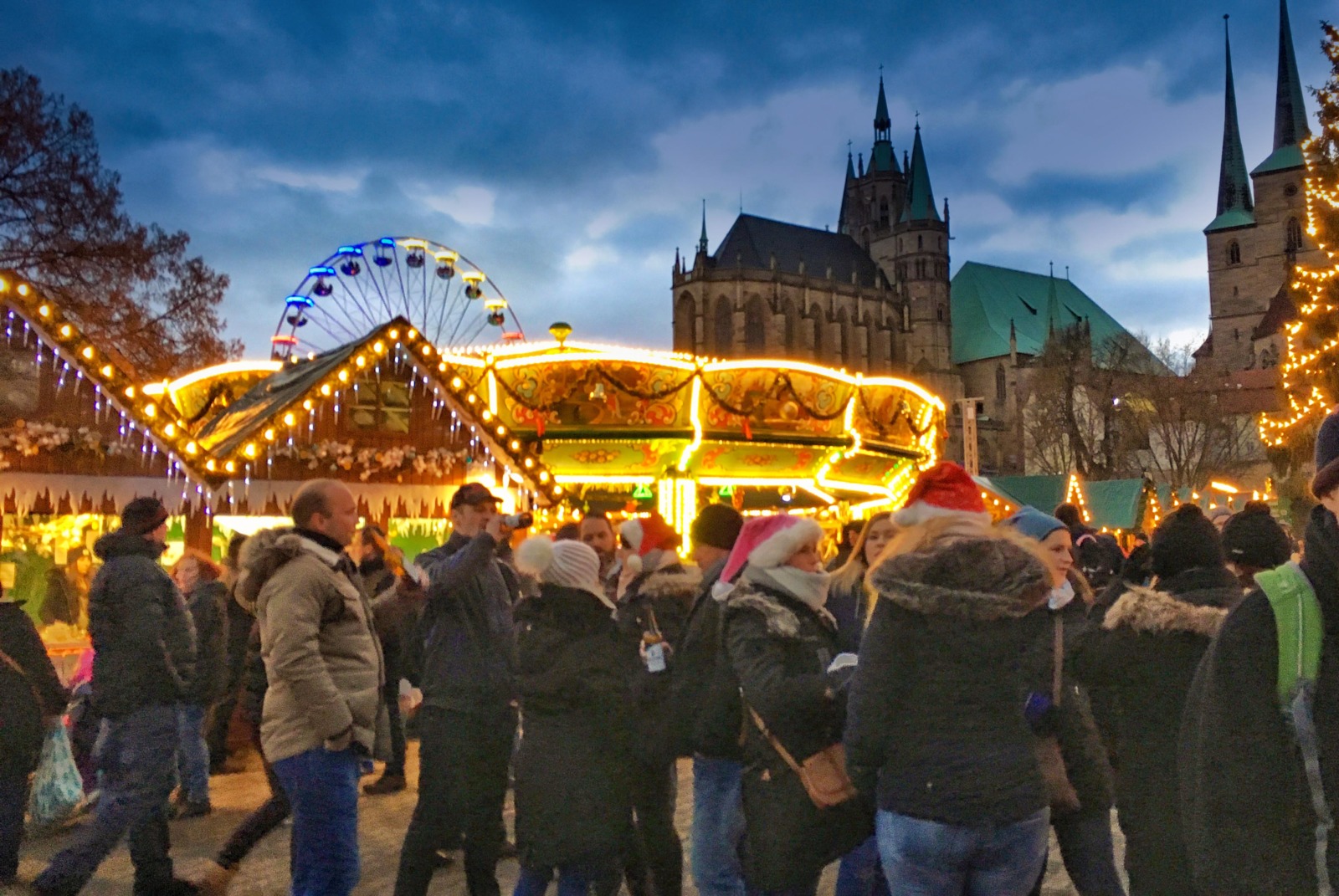
From a distance, the Erfurter Weihnachtsmarkt appears like an enchanting mirage. This is one of the reasons for the incredible number of visitors: over 2 million each year.
In 2021, the Erfurt Christmas Market will take place for the 170th time. The event occupies the Domplatz against the backdrop of the cathedral and the Severikirche. There are more than 200 stalls, and the market spills over into the adjacent streets and squares of the city centre: Fishmarkt, Schlösserbrücke, Anger and as far as Willy-Brandt-Platz.
A magnificent 25-metre-high illuminated Christmas tree stands in the middle of the Christmas market. A Ferris wheel offers a wonderful view of Erfurt’s historic centre.
You’ll find an eight-metre-high Christmas pyramid on Benediktsplatz, east of the city centre. The five-storey pyramid depicts characters from Erfurt’s history and Christmas scenes.
The local culinary specialities are Thuringian Bratwust and Erfurt Schittchen. The latter is a type of Stollen first mentioned in 1329.
Plan your visit to the Erfurt Christmas Market
- ℹ️ The official website of the Erfurt Christmas Market with practical info (opening dates and times, location and more)
- 🛌 Where to stay in Erfurt: choose from a wide selection of accommodation
- 🏰 What to do in Erfurt: check out the top activities in the city 👇
FRANKFURT CHRISTMAS MARKET

By Daniel and Ilona of Top Travel Sights • Follow on Facebook
The Frankfurt Christmas Market is one of the best and also oldest Christmas markets in Germany.
The first records mentioning the market date back to the late 1300s. Back then, locals called it the “December market”; over the years, it slowly turned into the Christmas market you can visit today.
The best place to start your visit to the Frankfurt Christmas market is on Römerberg, in front of a row of half-timbered houses. Here, you can find a giant Christmas tree, a merry-go-round and lots of stalls selling food and drinks. If you arrive on the weekend, you might also notice a stage in front of the town hall where choirs sing Christmas carols.
Mulled wine and Apfelwein
Germans are very fond of mulled wine, and you can buy it everywhere at the Christmas market. Frankfurt is located in one of Germany’s wine regions, and many local wineries set up their stalls at the market. Go to one of them, and you are guaranteed to get high-quality mulled wine.
Another popular drink at the Frankfurt Christmas market is hot Apfelwein. Apfelwein is a local drink from Frankfurt similar to cider but without the gas and with a more tart aftertaste. Usually, locals drink it cold, but at the Christmas market, many will enjoy a glass of hot Apfelwein with Christmas spices.
Local delicacies
The Frankfurt Christmas market is also great for trying some local cookies. Bethmännchen are almond cookies from Frankfurt, and Brenten are traditional cookies made from marzipan dough.
Besides food and drinks, you can also buy Christmas gifts and souvenirs at the market. The best place to do so is in front of St Paul’s Church, where you can find stalls selling handicrafts.
The best time to visit the Frankfurt Christmas market is on weekdays in the early afternoon. It can get very crowded in the evening, so make sure to arrive early enough!
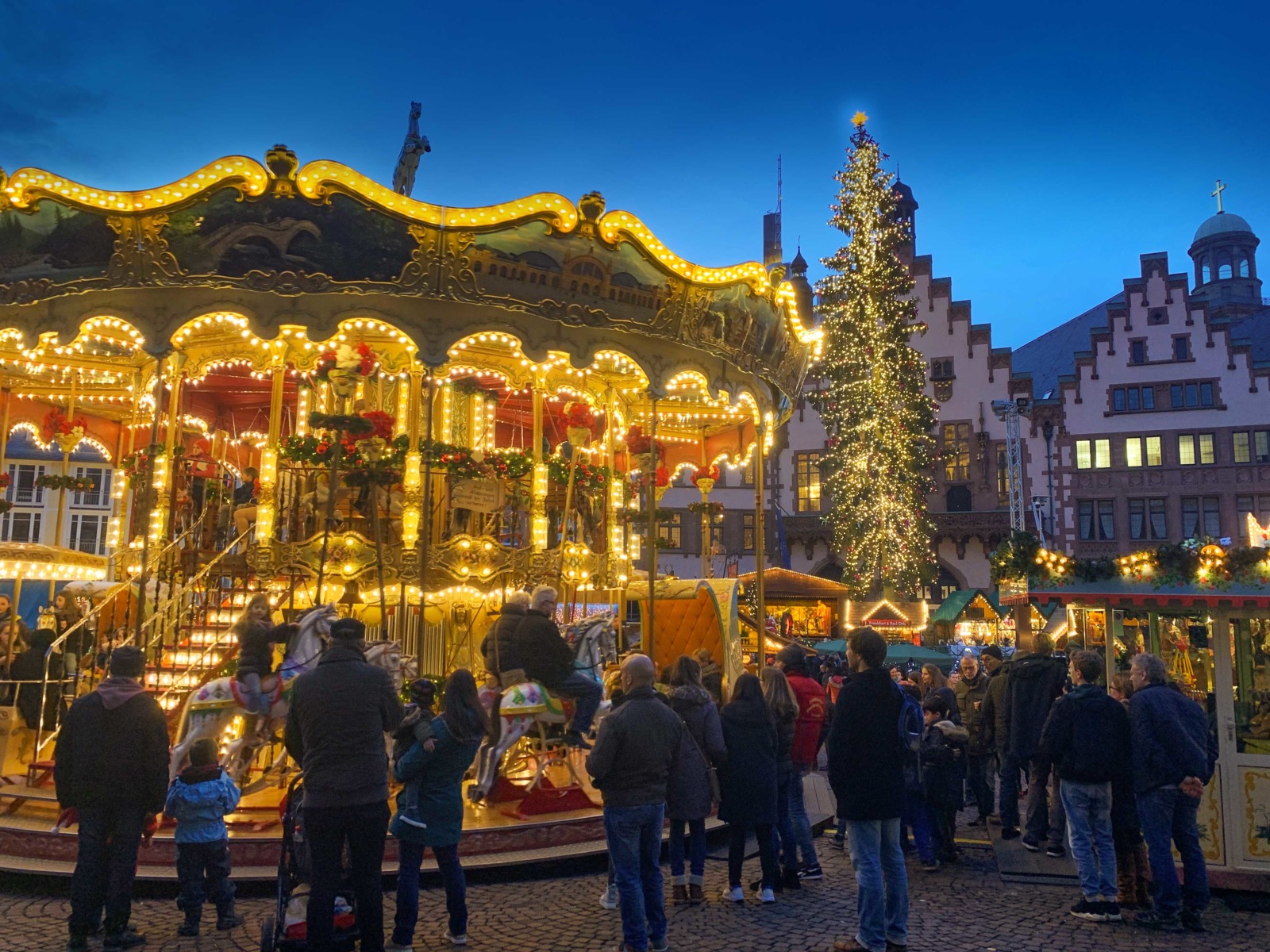
Plan your visit to the Frankfurt Christmas Market
- 🤩 The Frankfurt Christmas Market Discovery Guide
- ℹ️ The official website of the Frankfurt Christmas Market with practical info (opening dates and times, location and more)
- 🛌 Where to stay in Frankfurt am Main: choose from a wide selection of accommodation
- 🏰 What to do in Frankfurt: check out the top activities in the city 👇
FREIBURG IM BREISGAU CHRISTMAS MARKET
![Freiburger_Weihnachtsmarkt © Andreas Schwarzkopf - licence [CC BY-SA 3.0] from Wikimedia Commons](https://frenchmoments.eu/wp-content/uploads/2021/11/Freiburger_Weihnachtsmarkt-©-Andreas-Schwarzkopf-licence-CC-BY-SA-3.0-from-Wikimedia-Commons.jpg)
Freiburg im Breisgau is a historic town near Colmar, Mulhouse and Basel, and was once Austrian. During Advent, many visitors from France and Switzerland visit the Freiburger Weihnachtsmarkt.
The contemporary version of the Freiburg Christmas market dates from 1973. In the 19th century, a Christmas market was on the Münsterplatz (cathedral square).
The Christmas market has around 130 beautifully decorated chalets, most concentrated on the Rathausplatz (Town Hall Square). It also spills into Franziskanerstrasse and Turmstrasse, the Kartoffelmarkt and Unterlinden Square.
In 2021, an impressive lighting concept will decorate the Colombipark, offering a romantic atmosphere and a nice photo spot before the Colombischlössle.
Finally, the local speciality is the Freiburger Lange Rote, the queen of sausages, redder, thinner, more tender and more extended than conventional sausages.
Plan your visit to the Freiburg Christmas Market
- 🤩 The Freiburg Christmas Market Discovery Guide
- ℹ️ The official website of the Freiburg Christmas Market with practical info (opening dates and times, location and more)
- 🛌 Where to stay in Freiburg im Breisgau: choose from a wide selection of accommodation
- 🏰 What to do in Freiburg im Breisgau: check out the top activities in the city 👇
GENGENBACH AT CHRISTMAS
![The City-Hall of Gengenbach © Andreas Schwarzkopf - licence [CC BY-SA 3.0] from Wikimedia Commons](https://frenchmoments.eu/wp-content/uploads/2021/11/Gengenbacher_Rathaus_als_Adventskalenderhaus-©-Andreas-Schwarzkopf-Cologne-Christmas-Market-©-Eremeev-licence-CC-BY-SA-3.0-from-Wikimedia-Commons.jpg)
Gengenbach is a small Black Forest town in the Kinzig Valley. The former imperial town, which is twinned with Obernai in Alsace, is home to a major attraction that attracts more than 120,000 visitors every year: the world’s largest Advent calendar.
For more than twenty years, the town hall in Gengenbach has served as an Advent calendar with its 24 windows. Music, games and backlit windows turn the town hall into a “fantasy treasure chest”. The windows of the world’s largest Advent calendar house have already been decorated with works by renowned artists such as Otmar Alt, Quint Buchholz, Marc Chagall, Tomi Ungerer, Jan Peter Tripp and Andy Warhol.
During Advent, a Christmas market is held at the historic Marktplatz and along Victor-Kretz Straße.
Plan your visit to the Gengenbach Christmas Market
- ℹ️ The official website of Gengenbach with practical info (opening dates and times, location and more)
- 🛌 Where to stay in Gengenbach: choose from a wide selection of accommodation
- 🏰 What to do in the Black Forest: check out the top activities in the region
HAMBURG CHRISTMAS MARKET

The Hamburger Weihnachtsmarkt consists of several Christmas markets. Some are located in the suburbs of the city, while the most visited markets are in the city centre.
From Hamburg’s main railway station (Hauptbahnhof) to the Gänsemarkt underground station, the Christmas markets merge together to form an incredible Christmas route. At every corner, you can enjoy roasted almonds, gingerbread and nuts, not to mention the popular local mulled wine: Rathausmarkt-Glühwein.
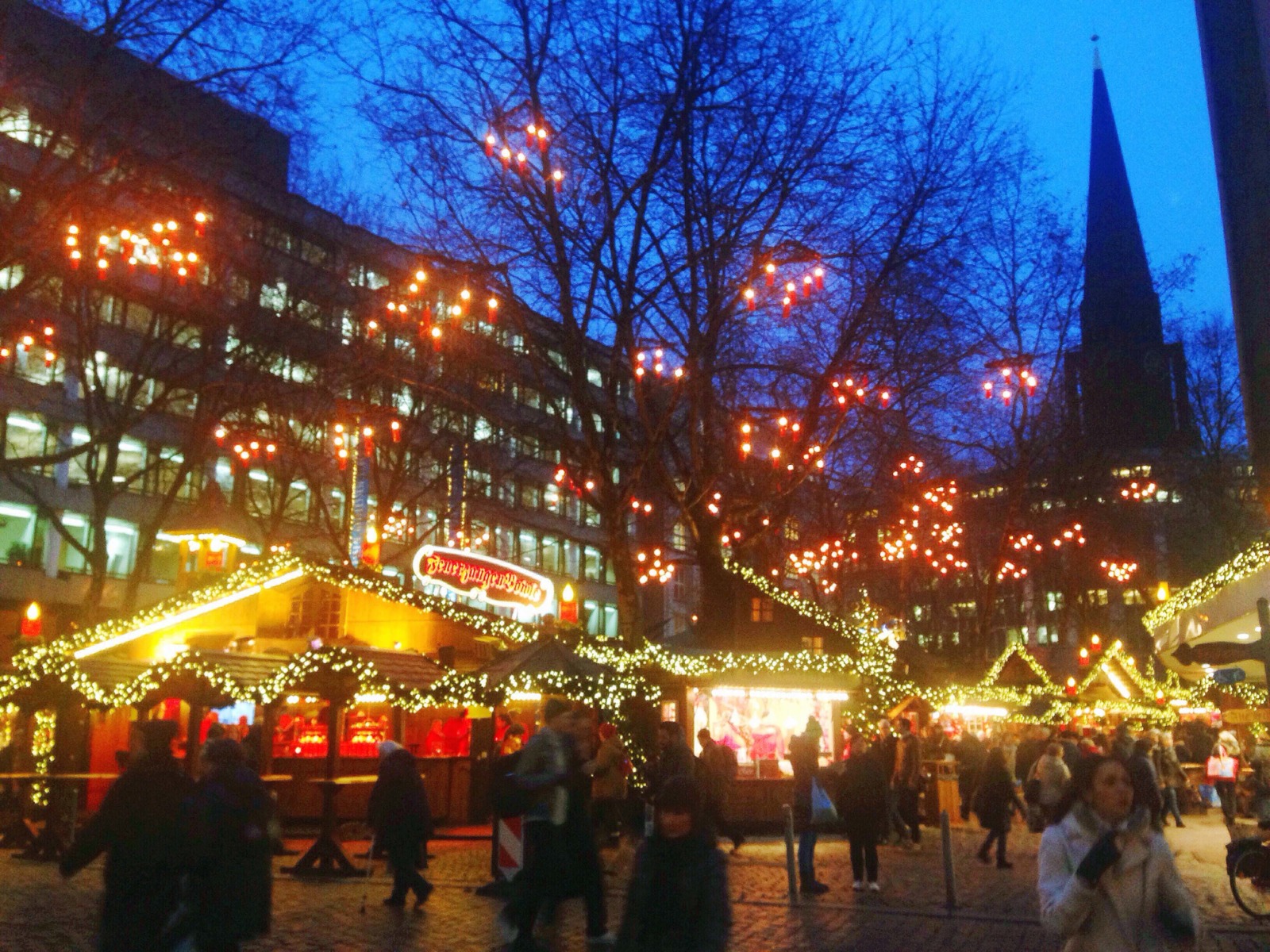
The central Christmas markets of Hamburg
Hamburg’s largest Christmas market is located in front of the town hall (Rathaus). It is a traditional market with wooden chalets. Its motto is “art instead of commerce”. There is an aisle dedicated to the sale of toys, handicrafts and woodcarvings from Tyrol.
On Spitalerstraße there are wooden stalls selling handicrafts. Nearby, at the junction with Mönckebergstraße, you can admire a large Christmas pyramid.
The Christmas market at Gerhart-Hauptmann-Platz / Mönckebergbrunnen evokes the atmosphere of a winter forest.
Around St. Petri’s Church, the chalets offer handicrafts and baked goods. There is also a fairy-tale forest for children.
The Gänsemarkt with its wide range of snacks is the place to go for food. This market is made up of gingerbread houses with elaborate decorations.
And if you stay in Hamburg on Christmas Day, you may have the opportunity to taste the famous traditional Christmas goose.
Plan your visit to the Hamburg Christmas Market
- ℹ️ The official website of the Hamburg Christmas Market with practical info (opening dates and times, location and more)
- 🛌 Where to stay in Hamburg: choose from a wide selection of accommodation
- 🏰 What to do in Hamburg: check out the top activities in the city 👇
HANOVER CHRISTMAS MARKET
![Christmas Markets in Germany - Hannover Weihnachtsmarkt © Dguendel - licence [CC BY 4.0] from Wikimedia Commons](https://frenchmoments.eu/wp-content/uploads/2021/11/Hannover-Weihnachtsmarkt_vor_der_Marktkirche-©-Dguendel-licence-CC-BY-4.0-from-Wikimedia-Commons.jpg)
The first mention of the Hanover Christmas market dates back to 1813 and took place three days before Christmas.
Each year, more than 2 million people visit the Hannover Weihnachtsmarkt, which makes it one of the largest Christmas markets in Germany. The organisers place great importance on creating a merry Christmas atmosphere across the historic town centre through careful staging.
The festive event totals 200 stalls and occupies several places in the town centre:
- the traditional market on the Marktplatz,
- the Finnish Christmas Village on the Ballhofplatz,
- the Wishing Well Forest on the Holzmarkt,
- the Lister Meile Christmas market and
- the Ernst-August-Platz in front of the railway station.
The Kröpcke is home to a magnificent 18-metre-high Christmas pyramid. Hanoverians consider it the symbol of their city at Christmas. From the first floor of the pyramid, visitors can enjoy an overview of the Christmas market and the surrounding area.
Also, a night watchman in costume rings the bell to signal the closure of the Christmas market every evening.
Plan your visit to the Hanover Christmas Market
- ℹ️ The official website of the Hanover Christmas Market with practical info (opening dates and times, location and more)
- 🛌 Where to stay in Hanover: choose from a wide selection of accommodation
- 🏰 What to do in Hanover: check out the top activities in the city 👇
HEIDELBERG CHRISTMAS MARKET
![Heidelberg by night © Georg Buzin - licence [CC BY-SA 4.0] from Wikimedia Commons](https://frenchmoments.eu/wp-content/uploads/2021/11/Heidelberg-by-night-©-Georg-Buzin-licence-CC-BY-SA-4.0-from-Wikimedia-Commons.jpg)
The romantic city of Heidelberg on the Neckar River is a popular tourist destination in Germany. During the Advent season, the old town is decked out with decorations and illuminations to delight young and old in a fairy-tale atmosphere.
The Heidelberg Christmas Market takes place on different sites such as Bismarckplatz, at the start of the old town and the vast square of Universitätplatz, which gathers around 70 stalls.
![Christmas Markets in Germany - Heidelberg © Daderot - licence [CC0] from Wikimedia Commons](https://frenchmoments.eu/wp-content/uploads/2021/11/Heidelberg-Christmas-Market-©-Daderot-licence-CC0-from-Wikimedia-Commons.jpg)
A temporary enchanted forest occupies the Kornmarkt square with illuminated fir trees and a giant Christmas pyramid.
On Karlsplatz, an ice rink awaits you with a fantastic view of Heidelberg’s castle.
During Advent, Heidelberg is definitely the place to be to experience an unforgettable Christmas romance!
Plan your visit to the Heidelberg Christmas Market
- 🤩 The Heidelberg Christmas Market Discovery Guide
- ℹ️ The official website of the Heidelberg Christmas Market with practical info (opening dates and times, location and more)
- 🛌 Where to stay in Heidelberg: choose from a wide selection of accommodation
- 🏰 What to do in Heidelberg: check out the top activities in the city 👇
LEIPZIG CHRISTMAS MARKET
![Christmas markets in Germany - Leipzig © Joachim Köhler - licence [CC BY-SA 4.0] from Wikimedia Commons](https://frenchmoments.eu/wp-content/uploads/2021/11/Leipzig-WeihnachstMarkt-©-Joachim-Köhler-licence-CC-BY-SA-4.0-from-Wikimedia-Commons.jpg)
The Leipziger Weihnachtsmarkt fits harmoniously into the historic setting of Leipzig’s city centre. The Leipzig Christmas market takes place on the market square (marktplatz) and Augustusplatz and extends into the adjacent streets. It is one of the oldest (1458) and largest Christmas markets in Germany. It has around 260 stalls and welcomes more than 2.5 million visitors.
The market is divided into several areas:
- On the Naschmarkt is the historic Christmas market with its large Christmas tree. Here you will find the famous Christmas decorations from the Ore Mountains and a large selection of toys, ceramics and spices.
- There is a Christmas pyramid (Feuerzangenbowlenpyramid) on the Nikolaikirchhof.
- On Augustusplatz, you will find a Finnish village, a Ferris wheel and a children’s fairytale land. There is also a multi-storey carousel which is very popular with the locals.
- On Marktplatz, from the balcony of the old town hall (now the City’s Historic Museum), you can enjoy a daily concert by traditional trombone players.
Finally, the food stalls offer freshly baked pretzels (Brezeln), Pulsnitzer Lebkuchen, Leipziger Glühwein (mulled wine) and Marillen-Punsch (apricot punch). And don’t forget the Feuerzangenbowle, a traditional German alcoholic drink where a rum-soaked sugar loaf is flambéed and poured into mulled wine.
Plan your visit to the Leipzig Christmas Market
- ℹ️ The official website of the municipality of Leipzig with practical info (opening dates and times, location and more)
- 🛌 Where to stay in Leipzig: choose from a wide selection of accommodation
- 🏰 What to do in Leipzig: check out the top activities in the city 👇
LÜBECK CHRISTMAS MARKET

By Mal of Raw Mal Roams •
If you’re up for an off-beaten track and authentic German festive experience, head to the quaint town of Lübeck situated up north, 1-hour drive from Hamburg.
The Lübeck Christmas market (Lübecker Weihnachtsmarkt) opens at the end of November through to the end of December and really transforms the town into a Christmas wonderland with an explosion of colours and scents of various festive foods. The main market is set in the heart of the historic town centre of Lübeck, dating back to the 12th century, in front of the St Mary’s Church. What’s a better scene for a Christmas market than medieval churches and historic buildings adorned with the ferry lights?
Visit the market in the dark!
For the best experience, visit the market in the dark to see all the beautiful lights, including the Ferris wheel. Wrap up warm and simply eat your way through the market. Start with the traditional marzipan Lübeck is famous for. It comes in different shapes and flavours, and it’s also excellent to buy someone as a gift. Other foods to try include fried potato cakes with various tasty toppings, curry sausages, chicken sandwiches, fried doughnuts and of course, the traditional German sausage and mulled wine!
Lübeck’s old town is a UNESCO World Heritage Site, and a visit to this charming town would not be complete without exploring its most famous landmark, Holstentor, a gate to the city in medieval times.
![Lübeck Christmas Market © Maurizio Moro5153 - licence [CC BY-SA 4.0] from Wikimedia Commons](https://frenchmoments.eu/wp-content/uploads/2021/11/Lübeck-Christmas-Market-©-Maurizio-Moro5153-licence-CC-BY-SA-4.0-from-Wikimedia-Commons.jpg)
Plan your visit to the Lübeck Christmas Market
- ℹ️ The official website of the Lübeck Christmas Market with practical info (opening dates and times, location and more)
- 🛌 Where to stay in Lübeck: choose from a wide selection of accommodation
- 🏰 What to do in Lübeck: check out the top activities in the city 👇
LUDWIGSBURG BAROQUE CHRISTMAS MARKET
![Christmas Markets in Germany - The Baroque Christmas Market of Ludwigsburg © geo pixel - licence [CC BY 3.0] from Wikimedia Commons](https://frenchmoments.eu/wp-content/uploads/2021/11/Ludwigsburg-Barockweihnachtsmarkt-©-geo-pixel-licence-CC-BY-3.0-from-Wikimedia-Commons.jpg)
Ludwigsburg is a town in Baden-Württemberg, about 12 km north of Stuttgart. It is twinned with Montbéliard in France, which was part of the Duchy of Württemberg until 1796. Like Louis XIV in Versailles, the town owes its foundation to Duke Eberhard-Louis of Württemberg, who built a magnificent baroque castle here in 1704.
During Advent, the theme of the local Christmas market is the Baroque period, which is reminiscent of the castle of Louisburg.
Thus, the Ludwigsburger Barock-Weihnachtsmarkt takes place every year during Advent on and around the market square (Marktplatz). The Ludwigsburg Baroque Christmas Market includes some 180 exhibitors. The decoration is inspired by baroque gardens and consists of illuminated angels that spread their glittering wings over the market square.
The Baroque Christmas Market is accompanied by a stage show (cancelled in 2021) and other festive events such as Baroque concerts in local churches.
Plan your visit to the Ludwigsburg Baroque Christmas Market
- ℹ️ The official website of the Ludwigsburg Baroque Christmas Market with practical info (opening dates and times, location and more)
- 🛌 Where to stay in Ludwigsburg: choose from a wide selection of accommodation
MAINZ CHRISTMAS MARKET
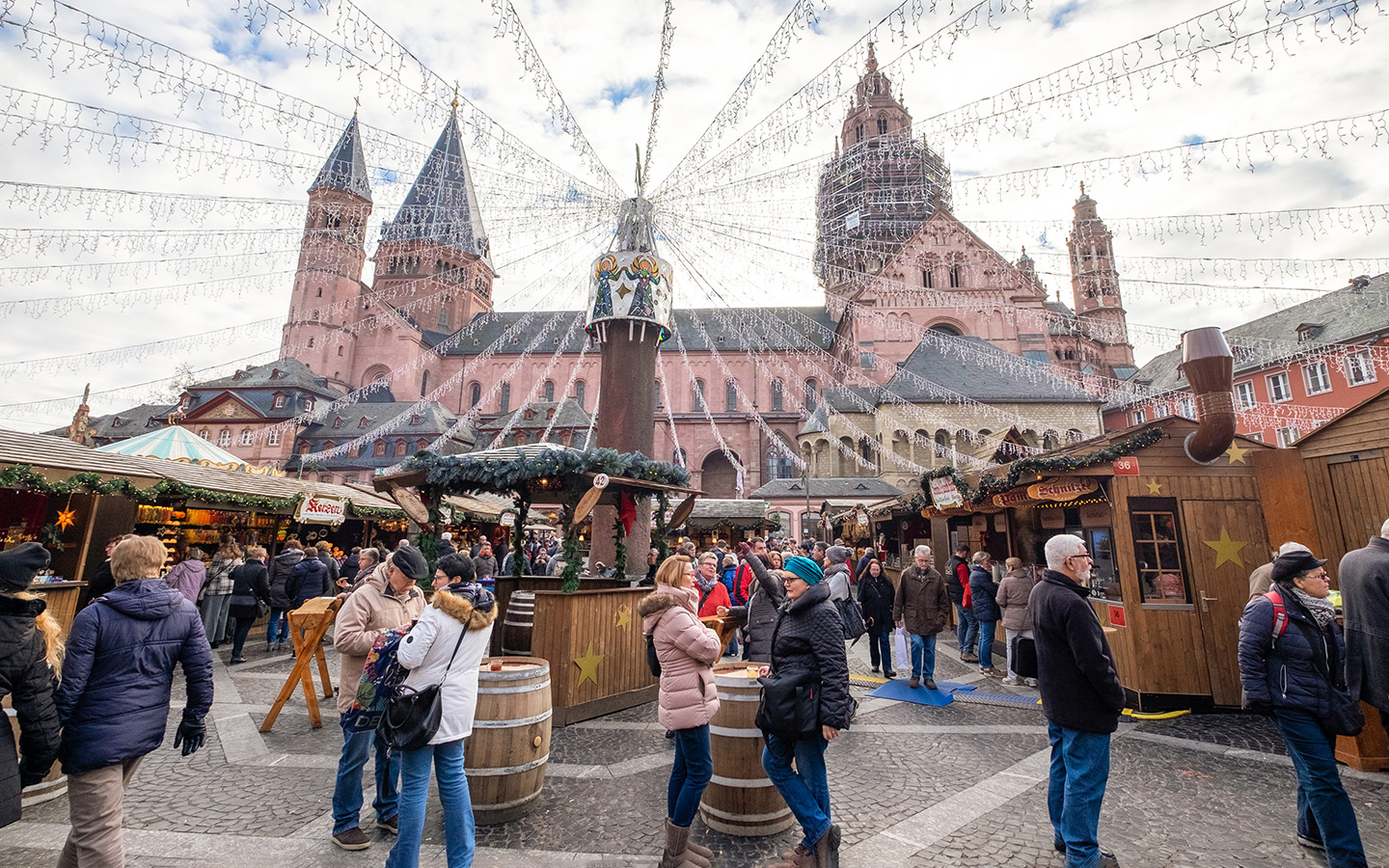
By Lucy at On the Luce • Follow on Instagram
Set on the River Rhine in the east of Germany, the historic city of Mainz is known as Germany’s wine capital and was home to Johannes Gutenberg, the 15th-century inventor of the printing press.
Mainz’s Christmas celebrations centre around the city’s cathedral, which combines a mix of Romanesque, Gothic and Baroque architectural styles. It’s well worth taking a look inside, and don’t miss the impressive hand-carved life-size crib figurines in front of the Gotthard Chapel.
Outside the cathedral, Mainz Christmas Market has over 100 stalls draped with greenery, baubles and sparkling fairy lights. The market has been taking place for over 100 years and is a traditional German market selling carved decorations, wooden toys, jewellery and other handicrafts.
Local delicacies
There are also lots of tasty treats to enjoy, with a mix of German favourites and local specialities like the ring-shaped Fleischwurst sausage and Reibekuchen potato pancakes. You can also buy high-quality glühwein straight from the local winemakers.
Outside the Gutenberg Museum, the Mainz Christmas Village is set on a raised platform with roaring wood fires where you can warm up with a hot drink in a pretty earthenware mug which makes a change from the usual Christmas market china. There are also cosy wooden huts you can reserve.
The Christmas pyramid of Mainz
The centrepiece of Mainz’s Christmas Market is the 11-metre-tall Christmas pyramid that rotates throughout the day and is illuminated at night. There’s also a nine-metre-high music box decorated with hand-carved wooden angels. And music performances add to the city’s festive atmosphere.
Plan your visit to the Mainz Christmas Market
- ℹ️ The official website of the Mainz Christmas Market with practical info (opening dates and times, location and more)
- 🛌 Where to stay in Mainz: choose from a wide selection of accommodation
- 🏰 What to do in Mainz: check out the top activities in the city 👇
MUNICH CHRISTMAS MARKET
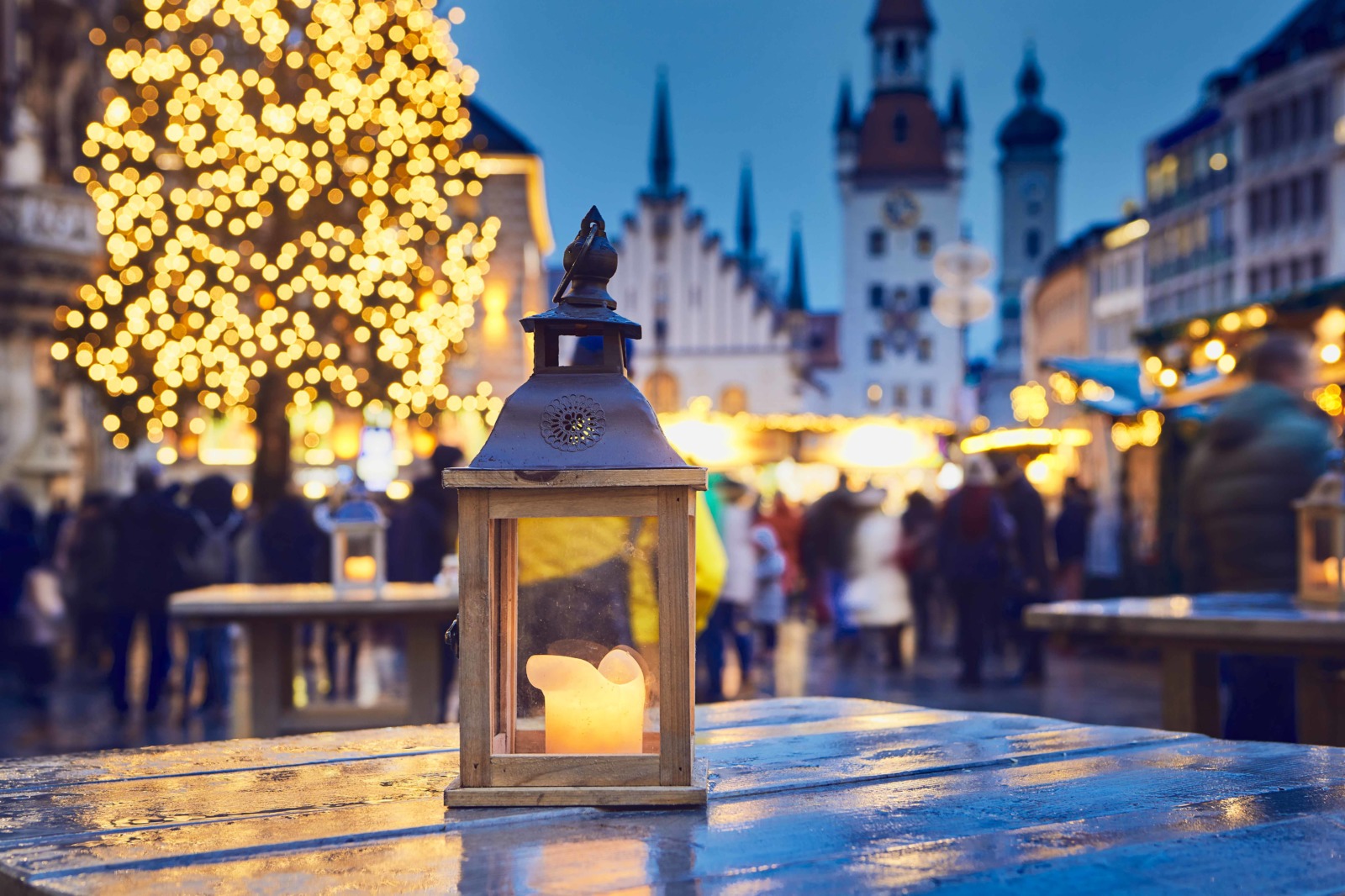
Unsurprisingly, Bavaria’s capital is a top destination at Christmas time.
The Munich Christkindlmarkt is one of the oldest of Christmas Markets in Germany. In 1310, a St. Nicholas market was first mentioned in a document in Munich. It was not until 1806 that the market was given the name Christmarkt.
The Christkindlmarkt am Marienplatz
Since 1972, the site of the historic Christmas market has been Marienplatz. This is Munich’s central square, bordered by the neo-Gothic Neues Rathaus building.
In the centre of the square stands a large illuminated Christmas tree, 30 metres high.
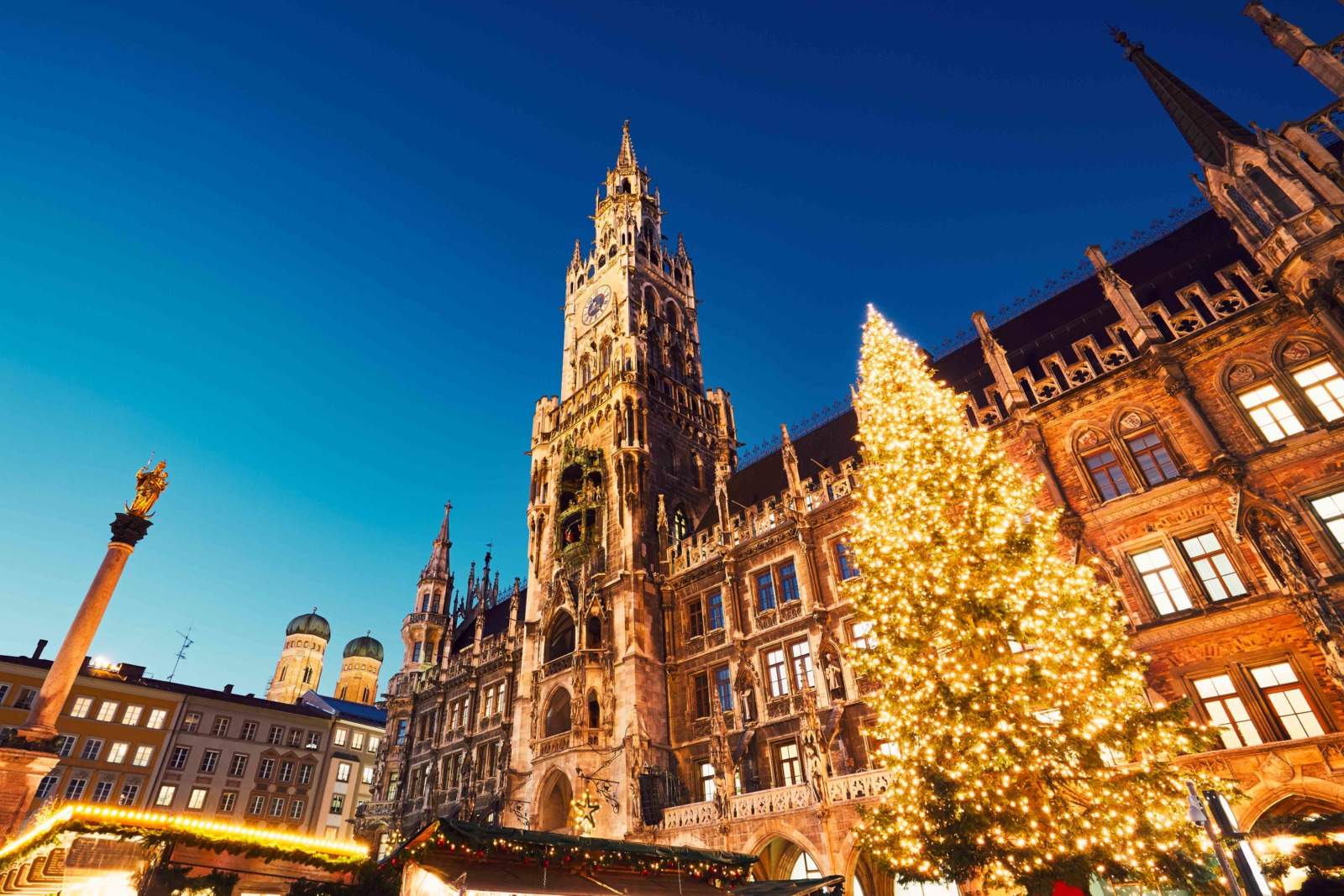
The Christmas market has retained its traditional Bavarian character, and its 140 stalls offer a variety of handicrafts. The assortment ranges from old German Christmas decorations such as hand-painted glass balls to lambskin jackets, old-fashioned paper pictures and products from the twin city of Kyiv.
The merchants offer stollen and Kletznbrot and prepare their own hot berry wine and herbal liqueurs. Small “Zwetschgenmandl” (dried fruit and nut figurines) are also handmade.
The Kripperlmarkt
To the west of Marienplatz, in the direction of Stachus (Karlsplatz), is the Kripperlmarkt, the Christmas cot market. Around the Richard Strauss Fountain (Neuhauserstraße), there are more than ten stalls selling exclusively nativity scenes, nativity figures and a wide range of accessories.
Christmas in Munich
Other large Christmas markets are held at the Chinese Tower in the English Garden, at Sendlinger Tor and Münchner Freiheit. There are also several Christmas markets in the suburbs of the city.
In addition, Munich offers an extensive programme of musical accompaniment and cultural events during the Advent period.
Finally, for the first time, the Christmas market at Marienplatz will be transformed into a New Year’s market from 27 December 2021 until 9 January 2022 with culinary and craft specialities.
Plan your visit to the Munich Christmas Market
- 🤩 The Munich Christmas Market Discovery Guide
- ℹ️ The official website of the Munich Municipality with practical info (opening dates and times, location and more)
- 🛌 Where to stay in Munich: choose from a wide selection of accommodation
- 🏰 What to do in Munich: check out the top activities in the city 👇
NUREMBERG CHRISTMAS MARKET
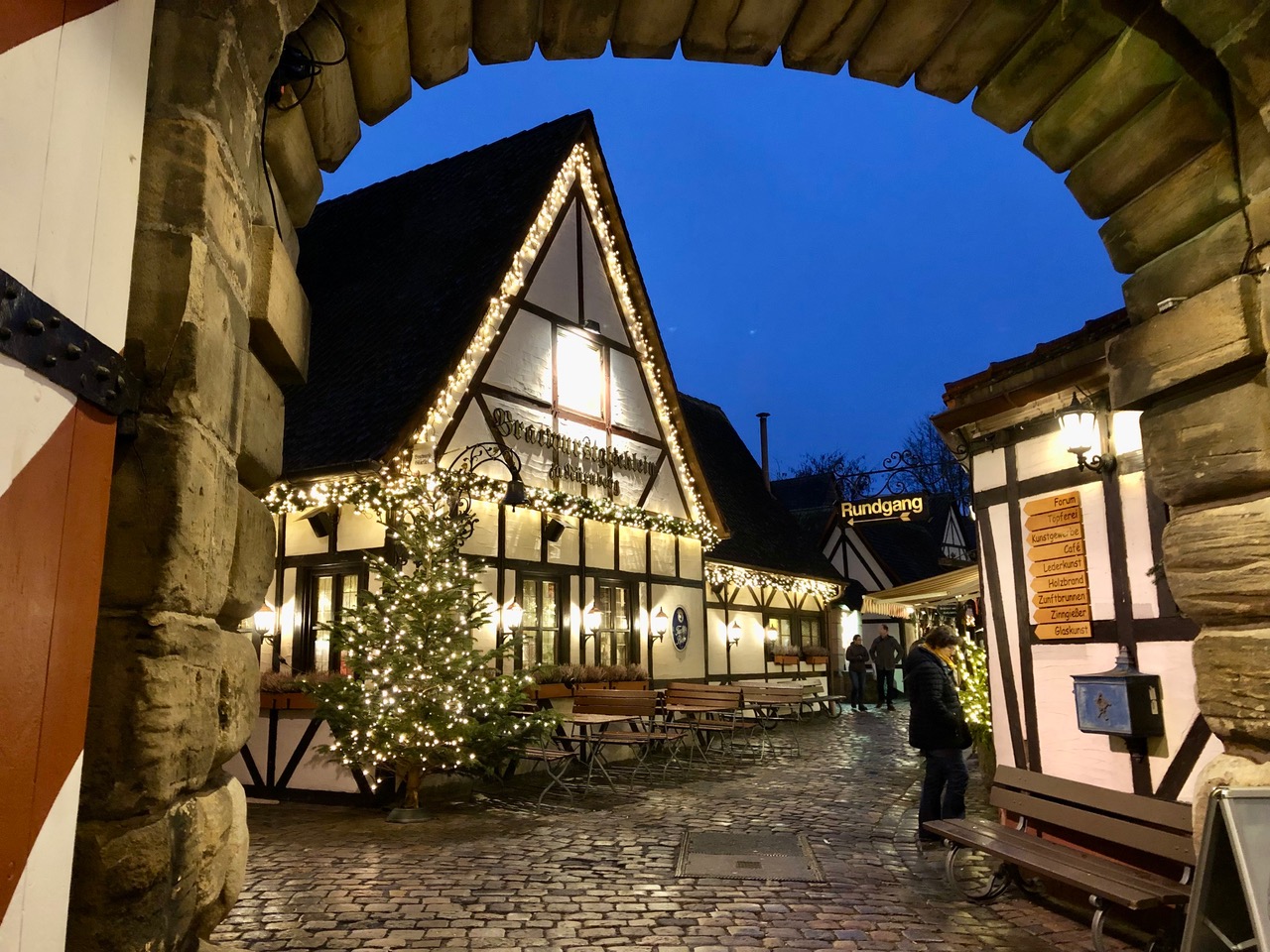
By Maria of Bavaria Travel Tips • Follow on Facebook
The Nuremberg Christmas Market, also known as Nürnberger Christkindlesmarkt, is one of the most popular Christmas Markets in Germany. Over 2 million visitors from all around the world come to this market every year to meet the Christkind (the German version of Santa Claus), drink Glühwein, and eat the famous mini brats from Nuremberg.
The market takes place on the main square, just below the medieval castle overlooking the city. Aside from the primary Christmas market, there are also a few smaller ones. The International Christmas Market features booths from Nuremberg’s 14 partner cities worldwide, from Cuba to Italy, Czech Republic to Nicaragua. Another fun market is located at the Handwerkerhof around the medieval city walls. You will find authentic handicrafts there and can watch the artists make their crafts.
Nuremberg is also famous for its delicious Gingerbread cookies. Filled with nuts, spices and dried fruit and covered with chocolate or sugar glaze, these cookies are a must-try during your visit to the Nuremberg Christmas Market.
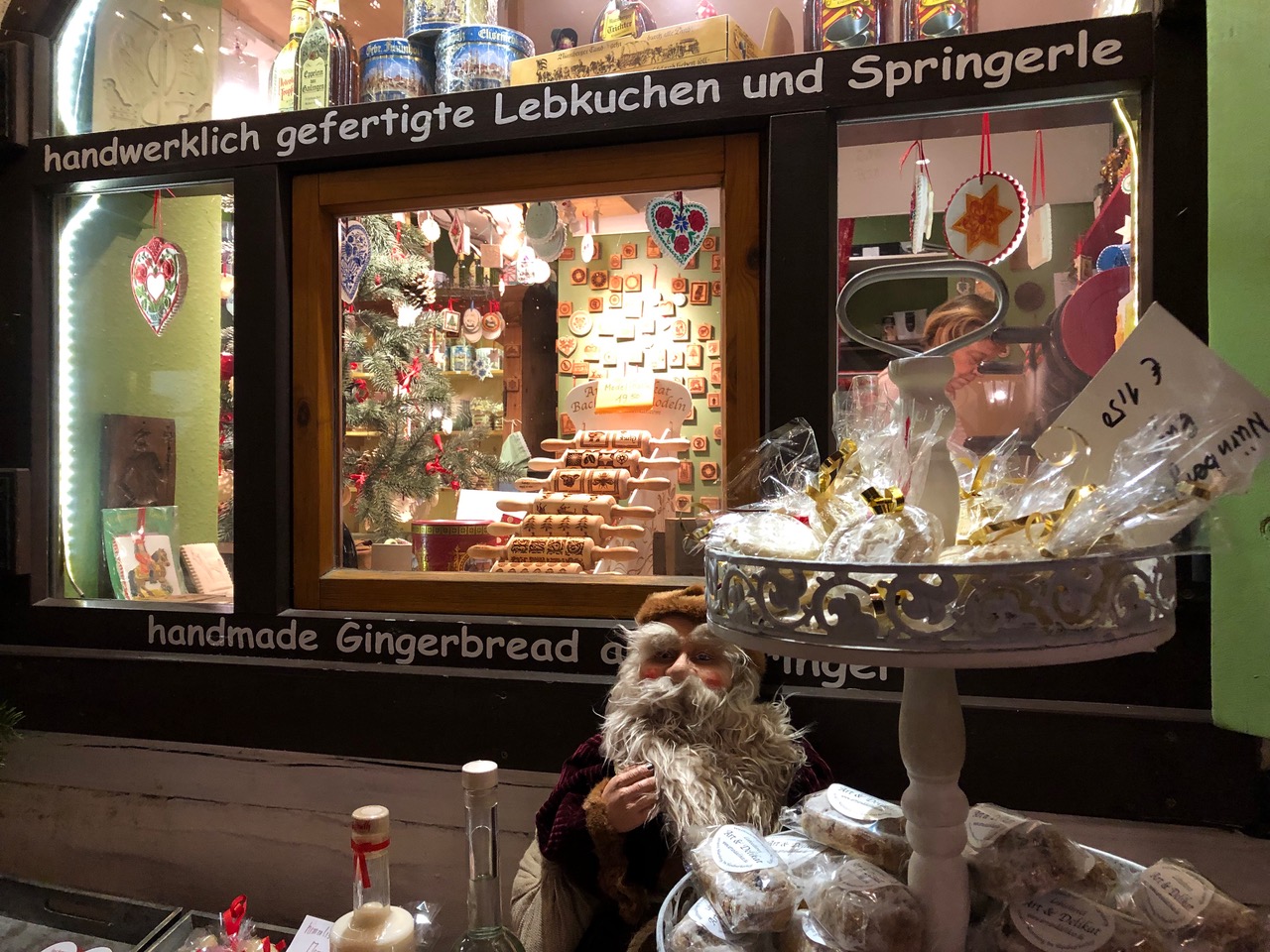
The charm of this historic city makes Nuremberg a MUST for all Christmas Market lovers.
Plan your visit to the Nuremberg Christmas Market
- 🤩 The Nuremberg Christmas Market Discovery Guide
- ℹ️ The official website of the Nuremberg Christmas Market with practical info (opening dates and times, location and more)
- 🛌 Where to stay in Nuremberg: choose from a wide selection of accommodation
- 🏰 What to do in Nuremberg: check out the top activities in the city 👇
RAVENNASCHLUCHT CHRISTMAS MARKET
![Christmas Markets in Germany - Ravennaschlucht © Andreas Schwarzkopf - licence [CC BY-SA 3.0] from Wikimedia Commons](https://frenchmoments.eu/wp-content/uploads/2021/11/Viadukt-Ravennaschlucht-©-Andreas-Schwarzkopf-licence-CC-BY-SA-3.0-from-Wikimedia-Commons.jpg)
Situated not far from the popular resort of Titisee-Neustadt and its emblematic lake, the Ravenna Gorge in the Black Forest mountain provide a fantastic backdrop of one of Germany’s most picturesque Christmas markets.
This is perhaps the most unusual German Christmas market. The Ravennaschlucht Weihnachtsmarkt spreads its chalets at the foot of a 40-metre high railway viaduct. At nightfall, the site is simply enchanting. And if the snow is added to the mountainous setting, the Christmas romance is at its peak!
The Christmas market is not very big (about 40 chalets) but allows its visitors to discover the traditional crafts of the Black Forest.
The Ravenna Gorge Christmas Market opens its doors during the Advent weekends. Tickets must be booked in advance to enter the Christmas market (up to 5.50 euros per adult in 2021).
Plan your visit to the Ravennaschlucht Christmas Market
- ℹ️ The official website of the Ravennaschlucht Christmas Market with practical info (opening dates and times, location and more)
- 🛌 Where to stay in Titisee-Neustadt: choose from a wide selection of accommodation
- 🏰 What to do in the Titisee: check out the top activities in the region 👇
ROSTOCK CHRISTMAS MARKET
![Christmas Markets in Germany - Rostock © Grand-Duc - licence [CC BY-SA 3.0de] from Wikimedia Commons](https://frenchmoments.eu/wp-content/uploads/2021/11/Rostock-Christmas-Market-Uniplatz-©-Grand-Duc-licence-CC-BY-SA-3.0de-from-Wikimedia-Commons.jpg)
The Rostock Christmas Market is considered one of the most important in northern Germany. It attracts around 1.5 million visitors annually, including tens of thousands of Swedish and Danish tourists who come to Rostock by ferry across the Baltic Sea on day and weekend trips.
The Rostocker Weihnachtsmarkt is over 3 km long with about 250 stalls. It starts at the Neuer Markt square and continues at the beginning of the Kröpeliner Straße.
Stroll along Kröpeliner Straße past traditional gabled houses and taste local specialities such as Rostocker Rauchwurst, Warnemünder smoked fish, baked bananas, Swedish glögg, Dresden Christmas stollen or Finnish honey.
The Universitätsplatz is the place for craftsmen. The pretty square is covered with a canopy of light.
The Christmas route then leads to the Kröpeliner Tor, where the large illuminated Christmas tree dominates the Christmas market.
Near the city harbour, the fishermen’s bastion hosts a funfair.
![Christmas Markets in Germany - Rostock © Grand-Duc - licence [CC BY-SA 3.0de] from Wikimedia Commons](https://frenchmoments.eu/wp-content/uploads/2021/11/Rostock-Christmas-Market-©-Grand-Duc-licence-CC-BY-SA-3.0de-from-Wikimedia-Commons.jpg)
The historic Christmas market takes place in the garden of the Zum Heiligen Kreuz monastery. More than 100 participants will take you back in time in a unique atmosphere on the ramparts. Trade, crafts, music and traditions… this is a unique and historic Christmas market!
Plan your visit to the Rostock Christmas Market
- ℹ️ The official website of the Rostock Christmas Market with practical info (opening dates and times, location and more)
- 🛌 Where to stay in Rostock: choose from a wide selection of accommodation
- 🏰 What to do in Rostock: check out the top activities in the city 👇
ROTHENBURG OB TAUBER CHRISTMAS MARKET

By Corinne Vail of Reflections Enroute
Rothenburg ob Tauber is one of the most charming cities in Germany, and its Christmas market (Alt-Rothenburger Reiterlesmarkt) is one of the most magical as well. December brings chilly weather, and there’s nothing better than sipping a hot mug of gluhwein as you wend your way through the labyrinthian cobblestone streets of the market.
In Rothenburg, you can take a tour of the Rathaus Tower (at city hall), where you can climb up the narrow spiral staircase and be rewarded with a view of the Christmas market stalls and decorations.
One thing you will want to try while you are in Rothenburg is the “Sneeballen” or “snowballs.” They are well-known in the city, probably because the recipe goes back 300 years. They are a delectable roll of shortcrust pastry that is covered in all kinds of toppings, such as chocolate, sprinkles, or, my favourite, cinnamon sugar.
A historic town
Rothenburg ob Tauber is surrounded by its medieval ramparts, and walking along these will give you stunning views of the countryside. There are many things to do to go inside and warm up, such as the Christmas Museum or if you’re feeling a little more adventurous the Medieval Crime Museum.
How to get there
It’s easy to get to Rothenburg either by train or car.
- By train, you will be dropped off in the centre of town, and it’s about a 15-minute walk to the centre of the Christmas market.
- By car, it will take you about 2 hours from Frankfurt or 2.5 hours from Munich. If you drive, park outside the ramparts and walk inside the old town.
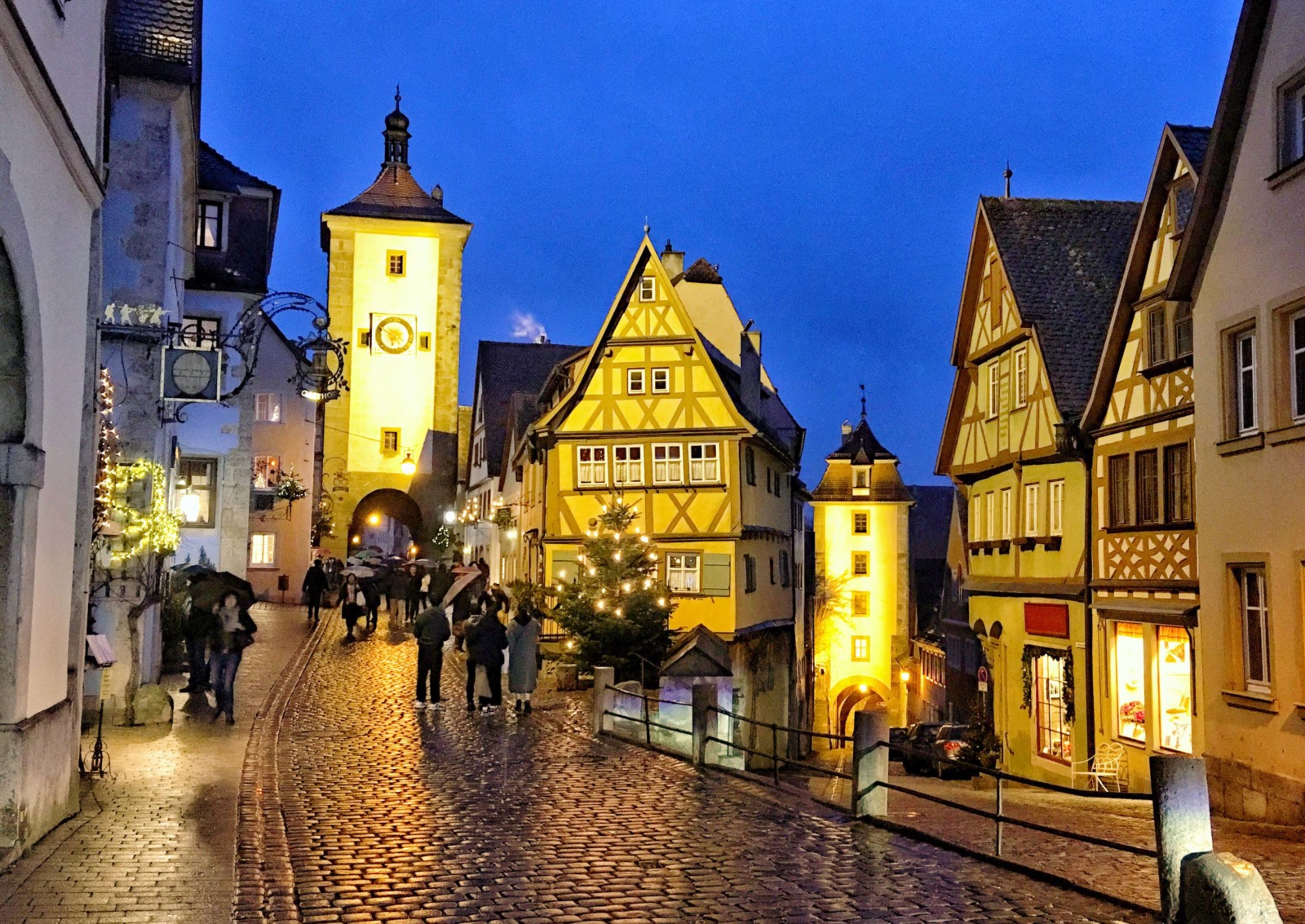
Plan your visit to the Rothenburg Christmas Market
- ℹ️ The official website of the Rothenburg Tourist Board with practical info (opening dates and times, location and more)
- 🛌 Where to stay in Rothenburg: choose from a wide selection of accommodation
- 🏰 What to do in Rothenburg: check out the top activities in the city 👇
SANKT WENDEL CHRISTMAS MARKET
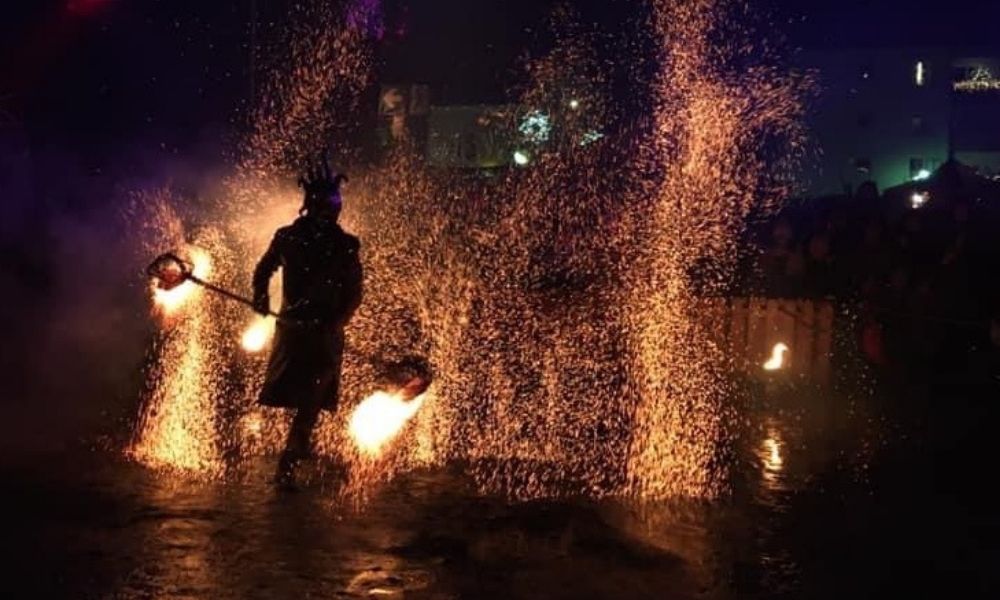
By Morgan Fielder of Crave the Planet • Follow on Instagram
Sankt Wendel delights people in Southwest Germany with its charming and unique “Christmas Magic” holiday market. The market is open from December 3rd to December 12th, 2021 and will require proof of vaccination, recovery, or testing to enter.
There is a traditional Christmas market with a giant wooden pyramid that spans the Old Town near St. Wendelinus Basilica. It fills you with Christmas cheer as you walk through 110 lovingly decorated huts offering handmade ornaments, delicious Glühwein and local crafts.
The Zwergen
Be sure to explore a bit down the alleys because you will find an entire “zwergen” or dwarf village with 30 different dwarf-filled nativity scenes. Each highly-detailed scene will show dwarves in their homes, churches and gardens preparing for Christmas.
For more excitement, wander with a steaming cup of your favourite Glühwein to the Middle Age Market. There, you can find original gifts such as animal furs, blacksmith crafts, and Middle Ages-style weapons. There are even camels and snow tubing for entertainment.
Stay until 7 pm, and your friends and family will love the fire shows with women dancing with fire, Krampus fire shows, and dragons built from paper that breathe fire at the crowds of laughing children.
This weekend getaway is located close to the French border, about 30 minutes from Saarbrücken, Germany.
Parking is located in an underground parking lot under the medieval market at the City Garage.
Check out Cafe Luise or Bruder Jakobs for a local and delicious meal.
Plan your visit to the Sankt Wendel Christmas Market
- ℹ️ The official website of the Sankt Wendel Christmas Market with practical info (opening dates and times, location and more)
- 🛌 Where to stay in Sankt Wendel: choose from a wide selection of accommodation
STUTTGART CHRISTMAS MARKET
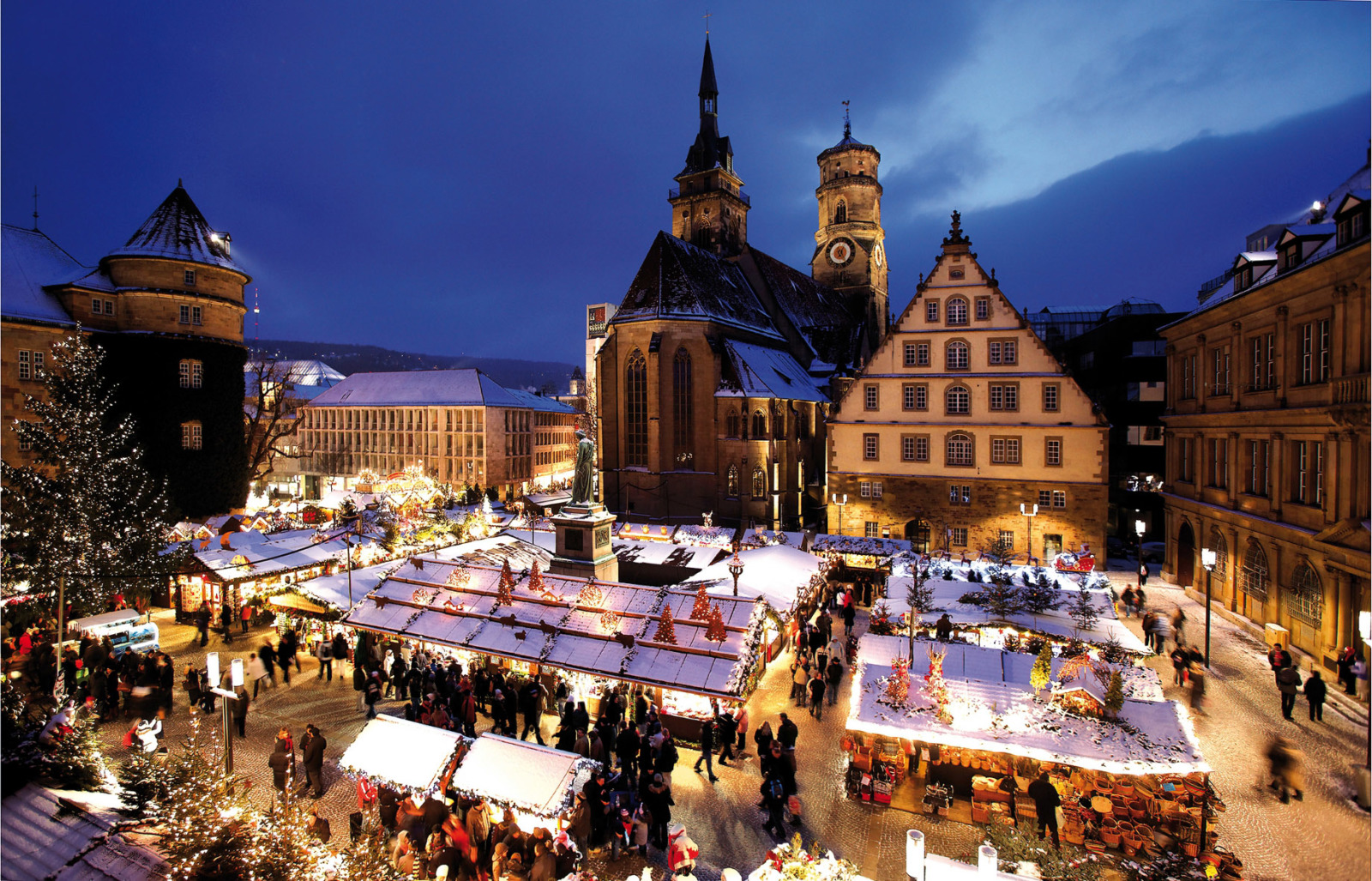
The state capital of Baden-Württemberg is home to one of Germany’s largest Christmas markets, with 280 stands and 4 million visitors.
The history of the Stuttgart Christmas Market
The first mention of the Stuttgarter Weihnachtsmarkt dates back to 1692. Until the 18th century, it was still a fair with tightrope walkers, magicians, jugglers and jesters. Animal demonstrations were also held in the menageries. In 1850, about 1,200 traders offered their wares for sale.
At the beginning of the 20th century, household goods and novelties (razors, model trains, gramophones) were on sale.
Then, in the 1970s, the Stuttgart Christmas market changed into its contemporary version: the old stalls made of folding tables, tent roofs and tarpaulins were replaced by uniform wooden chalets with elaborate Christmas decorations.
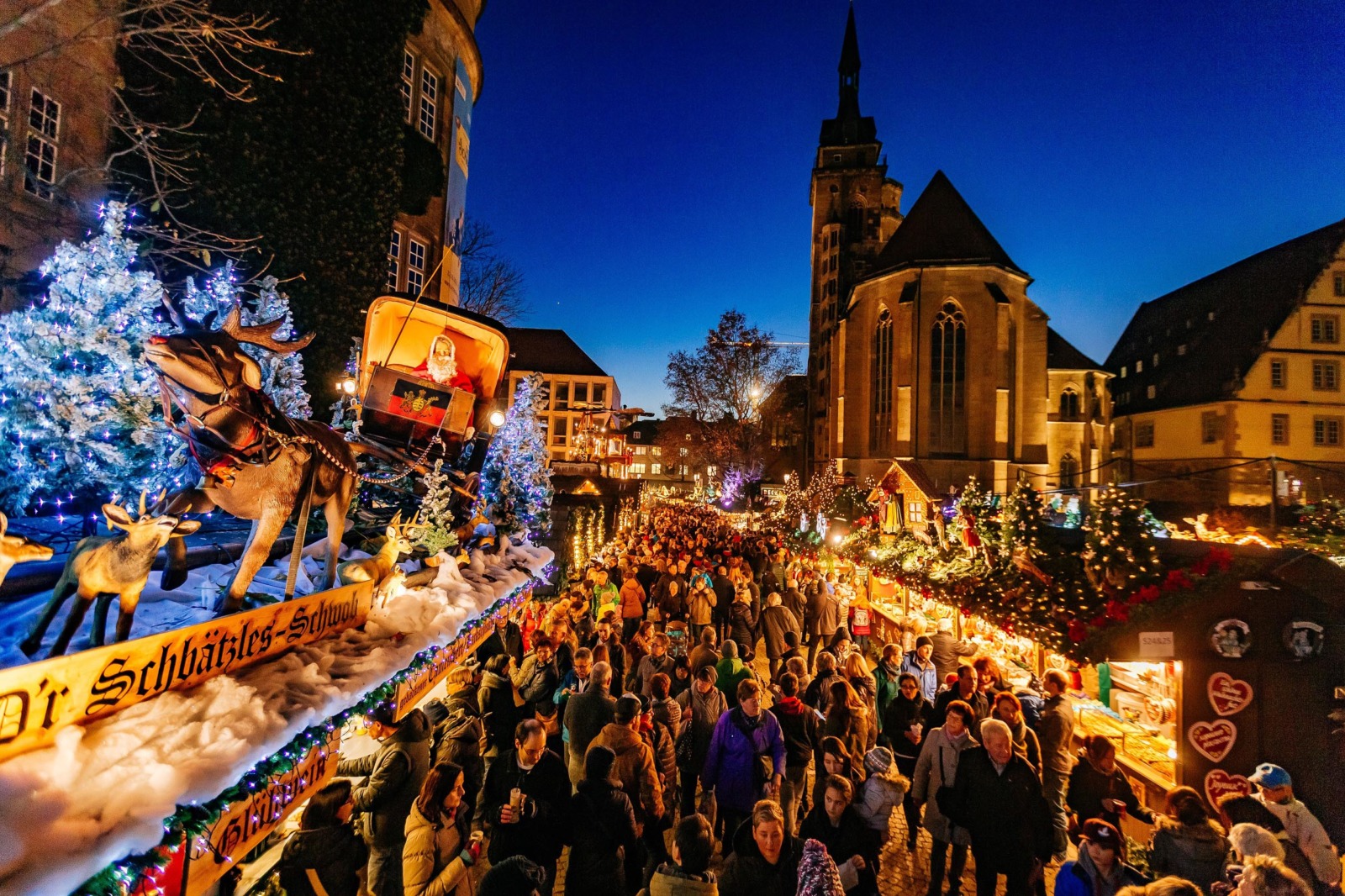
Christmas in Stuttgart
The main Christmas market takes place on Schloßplatz. The large square is also home to the children’s fairy tale land and the ice rink.
The Christmas market spills over into the squares and adjacent streets of the city centre, including Kirchstrasse, Hirschstrasse and Schillerplatz. Karlsplatz is home to the picturesque collectors’ Christmas antique market.
Finally, the Christmas illuminations on Schlossplatz and along Königstraße make the city centre glow during the Advent weeks.
Plan your visit to the Stuttgart Christmas Market
- 🤩 The Stuttgart Christmas Market Discovery Guide
- ℹ️ The official website of the Stuttgart Christmas Market with practical info (opening dates and times, location and more)
- 🛌 Where to stay in Stuttgart: choose from a wide selection of accommodation
- 🏰 What to do in Stuttgart: check out the top activities in the city 👇
TRIER CHRISTMAS MARKET
![Christmas markets in Germany - Trier Weihnachtsmarkt © Berthold Werner - licence [CC BY-SA 3.0] from Wikimedia Commons](https://frenchmoments.eu/wp-content/uploads/2021/11/Trier-Weihnachtsmarkt-©-Berthold-Werner-licence-CC-BY-SA-3.0-from-Wikimedia-Commons.jpg)
Trier, which is twinned with Metz in France, is situated on the banks of the Moselle in a very touristy region of Germany.
In 2021, the Trierer Weihnachtsmarkt celebrates its 41st edition. In 2021, the Trier Christmas Market was awarded the prestigious title of “Germany’s Best Christmas Market” by the tourism platform “EuropeanBestDestination”.
The large market occupies the main square bordered by the imposing Trier Cathedral and the cathedral courtyard. With its unique decorations, the market offers handcrafted Christmas decorations as well as delicious regional specialities. Local specialities, such as Winzerglühwein and Glühviez mulled wines, are particularly popular with French and Belgian visitors.
Plan your visit to the Trier Christmas Market
- ℹ️ The official website of the Trier Christmas Market with practical info (opening dates and times, location and more)
- 🛌 Where to stay in Trier: choose from a wide selection of accommodation
WÜRZBURG CHRISTMAS MARKET
Würzburg is located on the Main River and is the northern starting point of the Romantic Road. Since 1981, Würzburg has been a UNESCO World Heritage Site.
The Würzburger Weihnachtsmarkt is one of the most atmospheric Christmas markets in Germany, with the historic backdrop of the Falkenhaus and the Gothic Marienkapelle.
With around 100 stalls, the Christmas market offers various goods: spices, Christmas baubles, candles, ceramics, jewellery, and toys. Of course, mulled wine is not missing, nor are roasted almonds and local specialities from Franconia.
The beautiful historic inner courtyard of the Ratskeller (Domstraße) is home to the artists’ Christmas market.
Plan your visit to the Würzburg Christmas Market
- ℹ️ More info about the Würzburg Christmas Market with practical info (opening dates and times, location and more)
- 🛌 Where to stay in Würzburg: choose from a wide selection of accommodation
- 🏰 What to do in Würzburg: check out the top activities in the city 👇
Tip for visiting a German Weihnachtsmarkt
With Christmas markets becoming even more popular, with visitors coming not only from Germany but also from England, France or the US, it’s best to be prepared to avoid unpleasant surprises.
Practical tips
The best practical advice for visiting any Christmas market in Germany is to anticipate! Especially if you have never been there before. If you want to limit surprises (there will always be unforeseen events!), you need to do a little research. Where will you park your car? If I take the train, what are the train times and frequencies for the return journey?
First, check the dates and opening hours of the Christmas markets. These can be changed without notice for several reasons (e.g. the pandemic). Remember that in Germany, the date of the final closure of the Christmas market is 23 or 24 December.
The best thing to do is to check the websites of the local tourist office and contact them by phone or email.
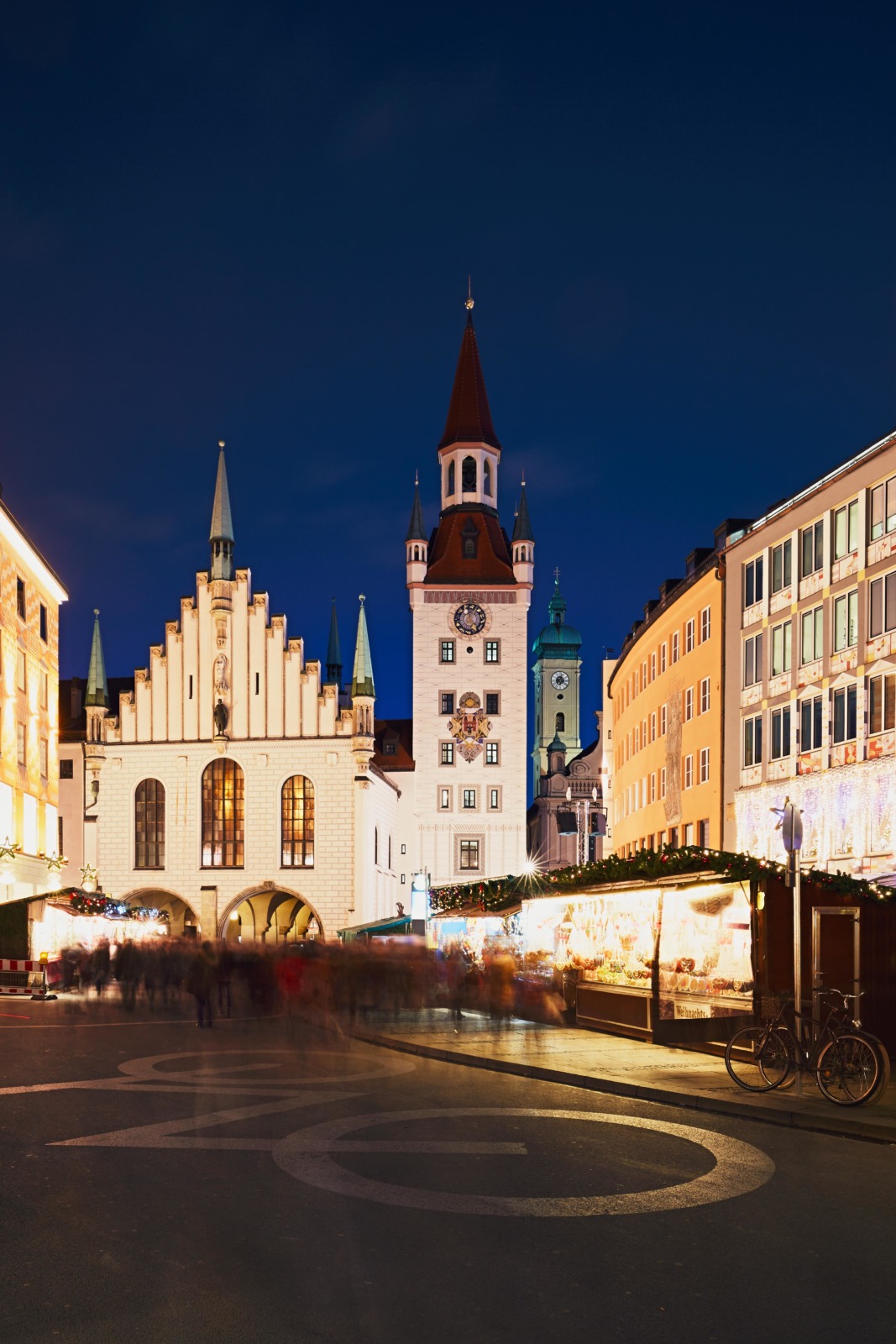
Visiting during the Pandemic
The pandemic has led to several changes in the organisation of traditional Christmas markets in Germany. After the historic cancellation of the festivities in 2020, most Christmas markets are back in 2021. Many are subject to the wearing of masks and/or the presentation of proof of vaccination.
The organisers of the Christmas markets in Germany are complying with the legislation in force to fight the pandemic. The rules may change, leading to adjustments or cancellations of Christmas events in the short term. It is best to find out about the Christmas markets before you plan your visit.
Book your accommodation
If you want to visit the Christmas markets in popular places like Berlin or Rothenburg ob Tauber, book well in advance to benefit from availability in hotels, rental flats, gites and B&Bs. Sometimes, you’ll need to anticipate almost a year in advance… although anything is possible in 2021 as attendance may be lower than Pre-Covid.
Avoid busy days
To avoid visiting Christmas markets on busy days, there is a trick. Don’t wait until the last week to see the most popular Christmas markets. For example, if you want to visit the one in Cologne, choose dates between the opening of the market and 10 December. Where possible, avoid the school holidays just before Christmas.
And avoid visiting the Christmas markets in Germany at the weekend, especially on Saturdays! For markets that take place on the four weekends of Advent, prefer planning your visit on Friday.
In fair weather, there will definitely be more people coming to the Weihnachtsmärkte. So don’t hesitate to plan your visit even if it’s raining!
And if a few snowflakes fall, the romance of a German Christmas will be complete!
![Christmas Markets in Germany - Rothenburg © Roderick Eime - licence [CC BY 2.0] from Wikimedia Commons](https://frenchmoments.eu/wp-content/uploads/2021/11/Rothenburg-at-Christmas-©-Roderick-Eime-licence-CC-BY-2.0-from-Wikimedia-Commons.jpg)
Access to the Christmas markets
Your choice will depend on whether you can reach your destination by train, car or even plane!
Coming by train
The train is the ideal way to get to a Christmas market. There is no need to stress about finding a parking space for your car. Moreover, the train stations are located in the city centre, so they are close to the Christmas market.
If you are travelling by train, remember to leave your bulky parcels at the manual lockers at the stations. Most central stations have them. This will allow you to visit the Christmas markets without carrying a heavy load.
Coming by car
To reach specific sites, the car remains one of the only means of transport. The roads leading to Rothenburg ob Tauber or Gengenbach can be congested on busy days. It can be difficult to find a parking space (even if you have to pay). Sometimes you have to park far away from the site and walk the distance in the cold, rain or wind!
Park-and-Ride facilities
Fortunately, some sites have set up free shuttles between the paid car parks and the village centre. This makes it easier to visit the Christmas markets even if the car is parked 3 km from the market! Check out the local tourist board to see if such an option is offered.
Coming by plane
Sometimes, it is worth coming by plane, particularly if you come from outside Germany. Most of the large Christmas markets in Germany are located near a busy airport with excellent connections with the rest of Europe: Frankfurt am Main, Berlin, Cologne, Munich…
Use public transport
To get to the Christmas markets in Germany’s big cities (Berlin, Frankfurt, Cologne, Munich…), don’t hesitate to use the public transport network. Some cities sell a special Christmas pass that allows you to use the tramway or bus for 24 hours. Check with the tourist offices beforehand.
A Christmas market wears out your shoes!
Put on good walking shoes to visit the biggest Christmas markets in Germany (Frankfurt, Berlin, Cologne, Munich, Dresden..). You may well find yourself walking a lot without even realising it.
Carry a backpack to carry your belongings (umbrella, water bottle…) and your purchases. I advise you to be careful with your most precious belongings (wallet, identity papers, etc). Beware of pickpockets!
Arrive at the Christmas market site around 4.30 p.m. If you are an amateur photographer or just a visitor, you will enjoy the blue hour before the dark! A very magical moment!
![Karlsruhe Palace at Christmas © H. Zell - licence [CC BY-SA 3.0] from Wikimedia Commons](https://frenchmoments.eu/wp-content/uploads/2021/11/Karlsruhe-Palace-at-Christmas-©-H.-Zell-licence-CC-BY-SA-3.0-from-Wikimedia-Commons.jpg)
Find out more…
- Read this article on the Christmas Markets in Germany in French on our blog Mon Grand-Est
- Strasbourg Christmas Market – our discovery guide of France’s premier and oldest Christmas market
- The Traditions of the Christmas markets in Alsace – including Strasbourg, Colmar, Mulhouse, Sélestat, Obernai…
- The origins and traditions of the Christmas pyramid in Germany
- Germany in French – read more about names of German places in French
- Discover the Moselle Valley from its source in France and its estuary in Germany
Pin the Christmas Markets in Germany for later
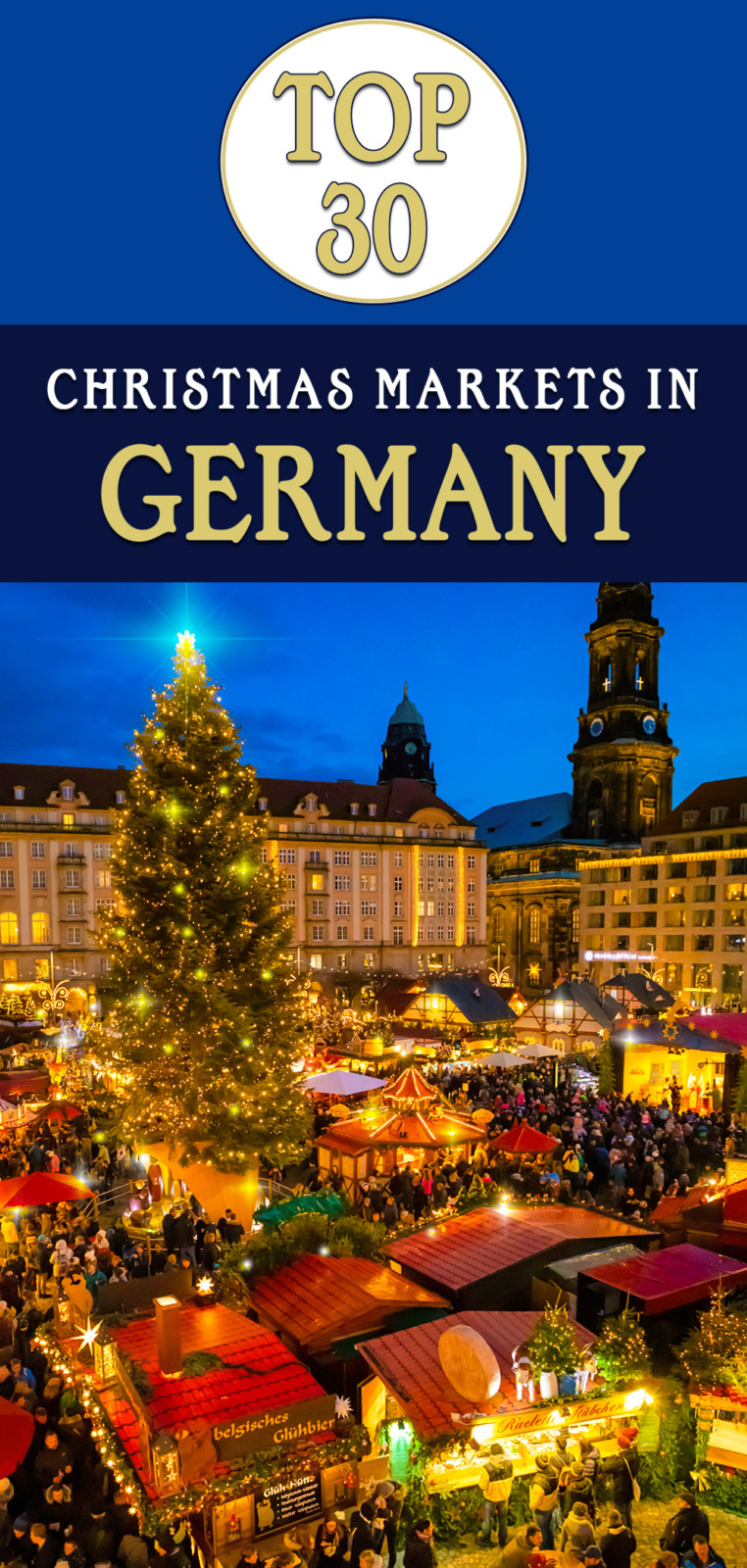


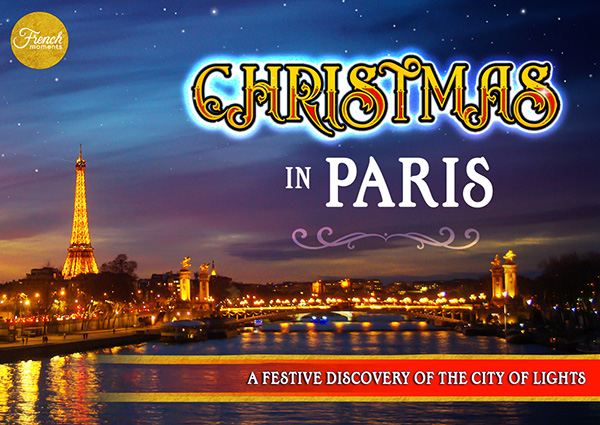


Great Christmas markets in Germany! I have been to the ones in Augsburg, Nuremburg, and Berlin. I so want to see more.
Thanks Pierre!!
Thank you David!
What an amazing trip this would be! The markets are so festive!
Hopefully, they’ll be in full swing next year for Christmas 2022! 🙂
Great to read about the history and background of the Christmas Markets. I’ve visited a few over the years, mostly near the Dutch border and the one in Hamburg numerous times. But I have a lot of new ones on my list to visit in the coming years.
Thank you Cosette! There are so many Christmas markets in Germany that we are spoilt for choice. 🙂